#Johannes is fascinating as a character but then we only see him like. three times max
Explore tagged Tumblr posts
Text
Charles: and how do I contact you in the future?
Johannes: you don't 🌟 bye you soggy bitch ✨️🕺✨️🕺🟨🟨🟨
#and then you barely see him for the rest of the game#the sinking city#coolhatposts#man i would have loved to be able to visit johannes's house! maybe you go there to discuss a case or catch up or whatever#i can totally see a dramatic parlor scene playing out that could give a lot more foundation for future story events#and maybe you can just visit his place sometimes and read philosophy books or something. maybe he rotates a couple books out for charles#on a table or smth and you can go read it#or maybe it's excerpts from lovecraft!!#GOD you guys do you see what i mean there's so much to add to the game#Johannes is fascinating as a character but then we only see him like. three times max#and at least one of those times he's probably dead#i just think it makes sense for charles to seek company with the only person he knows in the city a couple times before the plot starts#picking up. i could see maybe they have two or three dinners/drinks with Important Conversations#but i do think it's a wasted opportunity not to have johannes be more involved. he's the player's window into the upper class weird shit#in oakmont. he's our connection to a secret society and he knows graham and i would bet money he knew about the cannibal restaurant#GOD as soon as I'm done w the project I'm working on I'm gonna be replaying and writing SO MUCH you guys#never been a writer before but I'll make it happen#the possibilities are too cool to ignore#please please please someone else start posting abt tsc I KNOW YOU GUYS ARE THERE. I KNOW ME AND LOVELYHEADS ARE NOT THE ONLY ONES W IDEAS
10 notes
·
View notes
Photo
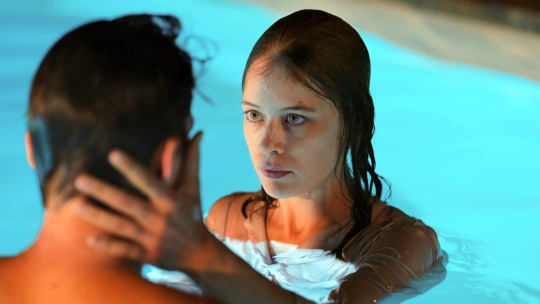
Siren Song.
Undine writer-director Christian Petzold talks to Reyzando Nawara about modern-day mermaids, Tinder culture and finding the magic in life.
“Love stories always change. A kiss in Berlin 1933, for example, is not gonna be the same kiss in Berlin today, right?” —Christian Petzold
“If you leave me, then I’ll have to kill you.” Undine’s threat to her soon-to-be ex-boyfriend Johannes, after he has told her that he has met someone else, seems at first like an over-the-top reaction to the breakup. But it is a curse that Undine must fulfill, for she will become human only when she falls in love with a man who is doomed to die if he is unfaithful to her.
From Splash to Ponyo to The Lure to Song of the Sea, mythical water spirits, usually female, sometimes horse, have powered many film plots. The sixteenth-century European myth of Undine, in particular, lies behind many screen adaptations of Hans Christian Andersen’s The Little Mermaid, though the Danish writer was not the first to popularize the fairytale in his century. Decades earlier, around 1811, Friedrich de la Motte Fouqué of Germany had produced his romantic novella, Undine.
And it is to Germany—specifically modern-day Berlin—that writer-director (and fellow German) Christian Petzold transports Undine in his contemporary magical-realist take on the myth. There, she does not take the form of a mermaid or siren, but a beautiful young woman (played by Paula Beer), who works as a historian at a museum, where she guides tours of Berlin’s architecture and its reconstruction. The breathtaking cinematography, by regular Petzold collaborator Hans Fromm, crystallizes both the romance and the beauty of Berlin, while Petzold’s leads root every scene in reality, even as aquariums explode and giant catfish drift past.
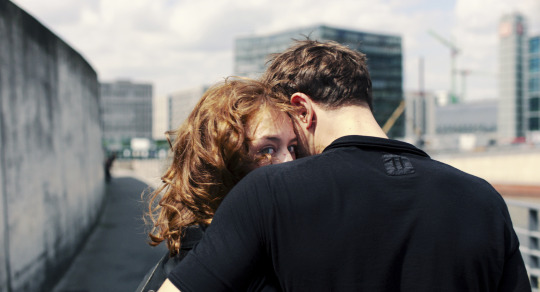
Paula Beer and Franz Rogowski fire up the streets of Berlin in ‘Undine’.
Water may be the dominant element in Undine, but Beer and her co-star Franz Rogowski bring fire to their scenes together. Where Beer brings charisma and intensity to the titular role, Rogowski, as Undine’s new love interest, an industrial diver named Christoph, offers charm and sweetness.
In the frenzy of Parasite’s world domination, it is easy to forget that Petzold’s previous feature, Transit, appeared in two of our 2019 Year in Review lists—the 50 highest-rated films and the highest-rated international films—and was one of the top romance films of the 2010s. His riveting Phoenix is still his highest-rated film on the platform—one of many to center a complex female character in search of love at a time of personal and/or political crisis. In Undine, Petzold does it again, a welcome departure from other adaptations, including the Colin Farrell-starring Irish romantic drama Ondine (2009), that have mostly told the myth from the perspective of its male characters. Petzold also revises the fairytale, by giving Undine a chance to try to emancipate herself from her curse.
We recently had the pleasure of speaking with Petzold about his fascination with water, the magic of Berlin history, modern dating and of course, his ongoing collaboration with Beer and Rogowski.
Spoiler warning: this conversation contains plot details regarding the ending of Petzold’s film ‘Transit’ (2018).

Your movie is inspired by the myth of Undine, but you reinvent it by giving it some modern twists. How did the main narrative for the film come about? Christian Petzold: I think the idea of the story first came to me around twenty years ago when I had a project in Germany. It was together with Claire Denis and also Kathryn Bigelow, and everybody had to make a ten-minute short film for a project based on the museum near the Rhine River. I had written a little dialogue—oh, by the way, Steve McQueen was also part of the project—and it was the scene that we can see in the movie in the first few minutes where Undine’s boyfriend, Johannes, said that he doesn’t love her anymore and that he wants to leave her and she said to him, “If you leave me, then I’ll have to kill you.” Then she goes back to work, and later when she comes back to try to find him again, he isn’t there—so she knows that she has to kill him now.
Then when I made Transit with Paula Beer and Franz Rogowski, I told them after a very lucky and happy time of shooting, that I had written a short story and wanted to make a 90-minute feature movie out of it together with them. I wanted to keep working and making movies with them because we’ve had an amazing experience together in Transit. This was basically the start of how the movie and my collaboration with these two actors came about.
Paula and Franz are actors who didn’t come from the basic German acting school; their backgrounds are dance and theater. But they both have so much curiosity about cinema—when I met Paula for the first time, for example, she told me that she had bought 50 movies by Alfred Hitchcock and wanted to see all of them, and to me, this is the best kind of school to learn about cinema.
So to some extent, Undine is a spiritual sequel to Transit? Yes, you’re right. It has so many things to do with Transit. Marie, Paula’s character in Transit, finds her own death in the sea—she’s drowned. And Franz’s character, he’s waiting at the land, hoping that she may come back from the land of the dead. So I said to them, “Okay, the next movie is gonna be about a woman coming out of the sea and going to the land to search for love and also about this young man who is a diver, who is going underwater, to find love as well.” So to some degree, it’s a sequel, you’re right.

Beer and Ragowski in ‘Transit’ (2018).
You mentioned earlier that you had a great experience working with Paula and Franz in Transit. Can you tell us what it was about these two actors that you thought would capture the story you wanted to tell in Undine? Paula is a very young actor—she was 23 when we started Transit, and she was around 24 when we made Undine—but when you’re filming her, she has this ability to make her characters much more mature beyond her real age. In one second, she’s 45 years old, with a whole experience of someone who’s had a hard life and has gone through so many bad things, then one second later, she’s thirteen and innocent. And to have that kind of ability—to go from one point to another—is just really fascinating to me. I’ve never seen other actors do this before in my life.
Franz was a dancer, and if I remember correctly, I think he was also in a clown school for a circus, so he can do everything with his body. It’s unbelievable what he can do. He has this amazing physicality that I admire and haven’t seen before in other German actors. When they’re together sharing a scene, they dance with each other. And this is the thing that I like so much about them and the thing I need in Undine, because I need actors who can float from one scene to another as if they’re dancing underwater.
In literature and pop culture, the myth of Undine has been mostly told from the male perspective. You reframe the narrative, to give Undine the opportunity to maybe emancipate herself from both the male figure in her life and the curse. Tell me more about that choice. Two or three years ago, I had a retrospective in New York, and I had the chance to see some of my previous movies again—[laughing] I’ve actually never done it before, revisiting my own movies. And at that time, I realized that I’ve always tried to rewrite the stories centering on women, which were made by men in the ’40s, ’50s, ’60s and ’70s, from another perspective: the perspective of the women.
When I was in Venice for the first time, Claude Chabrol [was] in the same hotel as me, and he had a Q&A. I wanted to say hi and tell him how great he was but I couldn’t do it because I was very young and too shy for those things. I heard what he said when asked why in his movies, the women are always the main characters. His answer was, “Men are living, women are surviving. And cinema is about surviving.” It was such a fantastic answer.
All the movies I [have] made, including Undine, are about surviving. Undine wanted to survive her curse—she tries to, every time, since centuries ago. In so many iterations of the myth, Undine always has to go back into the lake and to the life the curse has set for her. I really wanted to zoom in on that, to liberate the character of Undine from the myth and the curse.
In the movie, Undine works as an historian at a museum, and in her tours, she talks about Berlin’s architecture and its reconstruction throughout the years. How is this related to the romantic aspect of the movie? Everybody says you can take a love story and put it in the sixteenth century or the nineteenth century, and it’s always gonna be the same kind of love story. But I think that’s not entirely right. Love stories always change. A kiss in Berlin 1933, for example, is not gonna be the same kiss in Berlin today, right? Therefore I want to take the historical aspect of Berlin architecture and its reconstruction to tell the story of two young people in Berlin nowadays, to see the evolution of both this love story and the myth of Undine itself.

What’s the significance of all the buildings Undine mentions in the movie? The buildings serve a very important role in the movie because Berlin is between two rivers on an island, and the city is built on dried-out swamps, so the element that Undine is coming from, which is the water, is destroyed in Berlin. It doesn’t exist anymore. And therefore Undine doesn’t have any habitats, so she has no choice but to adapt and to live on the land.
In some way, I always think that the modernization in Berlin erases history, and when there’s no history, there’s no magic, which means magical creatures like Undine won’t exist. That was the main idea of the architectural elements in the movie.
Is that also the reason why there are two locations in the movie: Berlin, and the small town where Franz’s character, Christoph, works and lives, which is still full of swamps? To show that in this small town, magic still exists? That’s a good question. The romance and the myth of Undine is a part of German and European history. It’s a unique enchantment. But in Berlin, where modernization and civilization keep growing and changing, there’s no enchantment anymore. So I want to show how in this small town where everything is still kept as closely natural as possible, the enchantment and the charm of Germany are still there.
There’s a beautiful and romantic poem by Joseph Eichendorff that says, “You must find the right world, so everything can sync again.” To me, that line encourages us to find the magic of the world back. We live in this world surrounded by retro buildings and retro behavior and retro music, but it’s all actually just an illusion of magic. The real magic, that’s something that we have to find—either by movies or camera positions or poems or even by preserving the naturality of a city. And the Undine myth actually has a lot to do with this.
Another thing that fascinates me about the movie is how the dynamic between Undine and Johannes, in some way, reflects the state of modern dating. Is this something that you also wanted to capture when you wrote the script? [Laughing] Funny story, when Paula read the script for the first time, she told me that she liked it so much because the story reminded her of Tinder and modern dating. And on some level, it’s true; part of Undine is about modern dating. I always think that in the era of dating apps, everything gets much simpler—you meet someone, you have sex (or perhaps not), and if you feel like this someone is not handsome or beautiful enough for you, you can keep scrolling until you find someone new. So, dating right now is like going to the supermarket.
Johannes leaving Undine to be with another woman, who for him is better-looking than Undine, reflects the culture of Tinder. And the line I mentioned earlier, “If you leave me, then I’ll have to kill you,” is the opposite of that kind of dating life. And Paula, who hates Tinder, loves that line a lot. Some of the actors are on Tinder, I’m sure, and that’s understandable. Actors are sometimes very lonely because for six to eight weeks, they are deep inside of a character, and when they’re on break, they’re in some sort of “black hole of loneliness”.
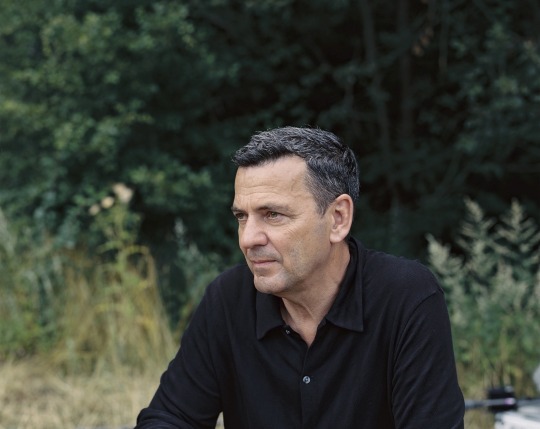
Writer-director Christian Petzold.
Undine being a water nymph, of course, makes the water element very important in this movie. But water has actually been heavily featured in some of your previous features as well, like in Yella, Barbara and Transit. Can you tell us why you find water fascinating? I’ve seen a documentary by Agnès Varda, and in [it] she said, “The place where one element is touching one another is the place where cinema builds its stories.” That’s why she loved the beach, because on the beach, there’s water and there’s the earth and there’s also wind, and they’re touching each other. So to her, the beach is the perfect place where you can tell a story.
For me, however, the reason I like featuring water or the other elements in most of my movies is because it has something to do with seeing my characters coming from one element then going to the other elements; to see them act and react in a new and sometimes uncomfortable place. Also, when you see pictures or paintings, so many of them are about people looking deep into the sea. I always feel like that kind of painting is actually about a desire. And most of my movies, at [their] core, are about desire. That’s why water is so important to me. Deep under the water, there’s the place of desire.
What’s the first movie that made you want to become a filmmaker? The first movie I loved very much as a kid was The Jungle Book, but the first movie that made me want to become a filmmaker was by Alfred Hitchcock, The 39 Steps. I was fourteen or fifteen years old when I saw the movie for the first time, and I loved it from the first moment. The movie is about a man and a woman who are bound by handcuffs, and they don’t like each other, but because they’re on the run, they have to communicate and come to an understanding. And the love story starts because of that communication, not because of looks, and I love the movie so much for that reason.
If you could program a double feature with Undine, what movie would you pick? Good question. I would say The Night of the Hunter. Also maybe Creature from the Black Lagoon or 20,000 Leagues Under the Sea or The Son’s Room by Nanni Moretti. These are the movies that I would recommend for a double feature with Undine.
Related content
More ‘Little Mermaid’ adaptations: a list by Katherine
Paula Beer strolling around towns cinematic universe
Diogo’s mega-list of Mermaids in Film
Horror’s History with Scary Mermaids: a Bloody Disgusting list
Follow Reyzando on Letterboxd
‘Undine’ is in theaters and available on VOD in the US now.
#christian petzold#paula beer#transit film#undine#undine myth#ondine#water nymph#mermaids#mermaid film#german film#german director#german screenwriter#german cinema#cinema germany#romance#romance films#Reyzando Nawara#franz rogowski#letterboxd#filmmaker#letterboxd interview
24 notes
·
View notes
Text
Binge-Watching: Monster, Episodes 45-48
In which we get a metric butt-ton of answers, ranging from terrifying to tragic to outright unsettling.
Answers Away!
Sweet buttery giblets, folks, we’ve got answers. Actual goddamn answers. After scrambling in the dark for so long, we’re finally starting to piece together a concrete picture of the life and times of one Johann Liebert, nee unknown, the nameless monster who entered life to wander the world forever in search of a name as he devoured the kindness of everyone foolish enough to grant him one. Between the acclimation of a tape recording Johann back when he was still in Kinderheim, the timely intervention of some surprisingly helpful Czech secret police with a vested interest in said tape, Grimmer being outed as a former Kinderheimer himself, and Nina’s return to the Three Frogs unlocking her own memories at last, these episodes weave a dense tapestry of reveals that have been a long time coming, most of which- unsurprisingly- leave us with further, yet darker questions to answer. But this time, it feels like the road ahead is actually shorter than the road behind us. This time, it feels like the pieces we’re left with form more than just a blurry photograph when placed together. This entire sordid saga is finally reaching a point of clarity, the fetid bowels of darkness finally being drawn up to the light. And as terrifying as the reveals are, there’s a great sense of satisfaction in starting to see the bottom of this rabbit hole at last. There’s nowhere to hide away from the darkness awaiting us now; now, there’s nowhere to go but forward.
So let us, indeed, go forward. Let’s piece together everything these episodes reveal to us and see the Monster before us with clear eyes.
The Kinderheimers
First, we turn to Grimmer, who, as mentioned above, turns out to be another one of the Kinderheim’s test cases. Grimmer’s always been one of the show’s most fascinating characters, but the air of tragedy this backstory affords him is almost suffocating. It’s no wonder he seemed so similar to Johann, hinting at a dark beast inside him clawing to get free; they underwent the same brainwashing and experimentation, albeit two decades apart. They’re both people split at the seams by the trauma they experienced there, with gnarled pits of darkness within them screaming to get out. Hell, they even both hide that monstrous self behind a pleasant, smiling face that seeks to put you at ease and earn your trust with kindness and compassion. The only difference is that while Johann seems to revel in that darkness, letting it consume him and destroy everything around him, Grimmer’s fully committed to rising above it. His kindness isn’t a facade, his compassion isn’t a ruse; it’s all genuine, all sincere, all committed to being a better person than the monsters at 511 Kinderheim tried to turn him into. It really does explain everything about him, doesn’t it? He’s a man whose been warped and twisted from a very young age, but who decided that he was strong enough to be better than everything his tormentors wanted him to be.
But even the best Bruce Banner can’t keep the Hulk inside him chained forever, and holy fucking Christ, was seeing the aftermath of his rage petrifying. The preceding shootout does such a fantastic job at ratcheting up the tension; when so many anime are centered around super-powered teens, you almost forget than in the real world, all it takes is a couple bullet wounds from trained killers to completely shatter the wills of unprepared civilians. It’s grungy and gritty and nail-biting, and watching Grimmer’s calm face descend into abject horror as he fights to keep in control of everything going wrong gets the pulse racing like nothing else... only for Tenma to burst into the scene just a minute too late and see a still, silent tableau of bloody bodies and crushed skulls, and right in the center of it all is Grimmer, standing tall and silent, once again as calm, composed, and kindly as ever, despite being stained red as the setting sun with the lives he just took. And once he finally registers Tenma’s presence, his first statement is a request to save Suk’s life, as casual as if they’d never left each other on that train. That is the terrifying duality of Kinderheim in a nutshell; shells of normalcy and comfort hiding maelstroms of self-destructive madness, Monsters inside growing larger and larger, just waiting for a chance to burst forth.
In a sense, it’s no wonder Johann ended up succumbing to the darkness inside him; even Grimmer, for all his dedication, is barely able to keep it together when forced into truly dire straights. It’s a last-minute rescue in a crisis, but it’s also a memento of everything he wished he could leave behind. There’s an incredibly telling moment in the aftermath of his latest Hulk-out, as Grimmer is rolling over scattered memories in his mind, and he mentions to Tenma that the hardest thing for him after graduating from that place wasn’t the spy training or regimentation; it was remembering how to smile. It was remembering the human emotions they tried to beat out of him. And now, in defiance, he embraces that kindness by keeping a smile on his face as often as he possibly can, constantly reminding himself of the humanity they tried to beat out of him. Even when making note of dangerous people watching him at a cafe, he doesn’t break a sweat. But even still, when faced with those memories in their rawest form- the tape of Johann’s past, the reminders from the Czech guy’s past- that pain comes seeping out all over again, replacing his compassion with fear and desperation. How many more people like them still exist? How many former Kinderheimers are still out there, feeling the Monster gnaw feverishly inside them, trying to keep it from bursting forth? Considering the program was active for at least two full decades, there’s no telling how many scars it’s left behind. And that thought might be the most terrifying prospect yet.
The Tape
Speaking of that tape, this is the first time we’ve been allowed a front-row seat both to Johann's childhood and the Kinderheim system that birthed him, so you better figure I’m hanging onto every word of it. It’s been touched on in the past how the Kinderheim was meant to scrub its pupils clean and remake them as perfect killing machines, but the conclusions gleaned from this tape, and the brownshirts’ desire for it, really drive home just what a dehumanizing affair it all was. Applicants were scrubbed of their past, their names, their identities, given lessons that made them forget who they were so they could be perfect little blank slates to experiment upon. The child Johann from the tape doesn’t even remember what his real name was; even as early as then, his identity was taken from him. But some things lingered all the same- fragments, pieces, mementos, shards of who they once were, and, most of all, the fear of losing any more than they already did. They knew it was wrong for them to be losing touch with the people they used to be, and they fought like hell to keep in touch, to not forget each other, to remember each other and everything they meant to each other. It’s such a simple, meaningless rebellion, but it’s also the most powerful statement they could have possibly made. Maintaining your sense of self in the face of a system that’s trying to strip it away from you? That takes all the guts in the world.
And for the first time, I’m beginning to understand what Johann is looking for. According to that tape, what he was most afraid of wasn’t his own pain; it was losing Anna, forgetting about her, letting her slip into the darkness of his mind like everything else he left behind. That’s what’s been driving him all this time; he wants to reclaim the person he used to be from the people who took it from him. He wants to remember his past, to get in touch with his lost memories, to once again grab hold of that legacy and never let it go again. And he wants those pursuing him to understand that too; there’s a reason he leaves a good portion of the tape for them to hear when he could have easily stolen or destroyed the whole thing regardless. He wants them to understand why he’s doing this. He wants them to understand the magnitude of reclaiming his past, even if he’s going to make it as hard as possible for them to keep following him. And honestly, as awful a person as he is, I can’t say I don’t sympathize. Just look at Grimmer, who’s so overwhelmed by reclaiming a bit of his memories that he rushes back into a dangerous den of secret police just to spill his guts to their leader about the nephew he shared his experience with, all the simple, human things that made him... him. Adolph Reinhart was just a single boy, but he had an entire life of his own stolen, a life that deserves to be remembered and cherished for all it was. Doesn’t Johann, for all his crimes, deserve that same grace? Doesn’t the nameless monster deserve to reclaim his name at last, to find peace from the darkness he was born into after spending so much time as a person not his own?
Seeing Double
But then, who is Johann Liebert, really? Who was the lost boy who became the monster tearing this world apart? Well, we’re starting to piece that answer together as well, and hoo boy, does it not look pretty. Because at long last, we’ve figured out where the picture book ties into this mess; its author was the member of the secret police who took Johann and his mother away, leaving Nina behind in that flat above the Three Frogs. And that’s not all; his sketchbook, full of pictures of a pregnant woman who gave birth to twins, suggests that the mysterious Bonaparte is none other than Johann and Anna’s father. It makes such perfectly twisted sense when you think about it; why else would Johann have become so attached to this book, except that they read it to him on the regular? And what better excuse to read it over and over again than you’re the person who goddamn wrote it in the first place? And should you wish to cart a certain family away to be re-educated, who better to help track them down than the husband who knows them like the back of his hand? Frankly, it’s so logical I’m surprised it didn’t occur to me before. But where does that leave us? When did the twins’ mother separate from their father, and why? When did the mysterious moment Johann talks about in that tape occur, when he saw countless people dead and thought he and Anna might be the last people left alive. And most importantly, what happened to bring these twins back together once the Kinderheim burned to ash?
Actually, that last question has a potentially far more terrifying answer than I could have suspected, because Nina’s resurfacing memories lead her to a recollection that makes no goddamn sense. She remembers Johann and her mother being taken away by the secret police, being left alone, but them she remembers someone coming back, someone returning, and the door opens to reveal... herself, saying “welcome home” right back to herself. And suddenly, the entire picture has gotten infinitely more complicated. How does Nina remember herself in two places at once? Was she the child who was taken away, or the child who stayed home alone? Was this something Johann implanted in her? Was she taken to the Kinderheim after all? All I know is that for as many answers as we’ve gotten, the road ahead is still packed with thorns and razor wire. And I wouldn’t have it any other way. Monster’s only got so many more secrets left to reveal; let’s see what else it has in store.
Odds and Ends
-Now that I know that’s Johann under that wig, his fake is unmistakable and scary as fuck. Though how did he get those gunshots off without anyone hearing?
-Dr Kenzo Tenma, pulling all-nighters in newspaper archives since 1995.
-Ah, of course Tenma sees himself in Suk. Another up-and-comer falsely accused by deadly whiskey bonbons.
-”They’re a lot safer with your mother than here with us.” Okay, that scared the crap out of me for a second, but that tactic actually makes sense. Cool.
-Jesus... wow. Kinderheim was so good at propaganda that it had secret police literally fighting tooth and nail to enroll their kids in what they thought was a reform school. That’s a whole new level of evil.
-You know, it’s funny; I’m watching Babylon this season, and it’s got a villain who’s a lot like Johann. They’re supernaturally gifted manipulators who turn people against themselves with just a few words, and they’re well aware of the immorality of their actions. But whereas Johann is a legitimately compelling character, his counterpart in Babylon... woof. Let’s just say I’m gonna have words once this season’s over.
-”Wait a minute, I’m forgetting that I’m on vacation. Make it a beer.” Lunge’s like an alien trying to retrofit himself into casual human society from the outside in, and it’s great.
We’re really in the thick of it now, folks. And I can’t wait to see what comes next. See you then!
5 notes
·
View notes
Text
The Best Films of 2018, Part II
Part I is here. Let’s keep it moving. ENDEARING CURIOSITIES WITH BIG FLAWS

103. Zama (Lucretia Martel)- In this movie there's a motif of Zama, an officer of the 18th century Spanish Empire, starting a scene by talking to someone or staring at someone off camera. After a minute or two, the camera cuts to some servant and disorients us. There's a person there, always there, to serve him, and it doesn't really matter who it is. It's a brilliant way to get at the colonialism that the character depends on but is still trapped by. So I get a little bit of what the film is trying to do, but it's boring. I'm an ignorant person who doesn't know how to watch Lucretia Martel's films or have any context for South American history, but I know what boring is. 102. I Feel Pretty (Abby Kohn and Marc Silverstein)- I like that Schumer tried something different instead of falling back on her persona, but there isn't enough new or interesting here for me to recommend--besides National Treasure Michelle Williams, of course. The film nearly displays "Do you see that she's turning her back on her real friends now?" on the screen. 101. A Simple Favor (Paul Feig)- At times cheeky and sexy and juicy, but it still wears out its welcome by twists ninety-one and ninety-two. 100. Double Lover (Francois Ozon)- Diverting until it gets silly, then so silly that it gets diverting again. There are about five too many twists, and I'm still unclear on how seriously the film takes any of those twists. More importantly, I don't think there's much of a takeaway from any of it. Ozon seems to have found a real muse in Marine Vacth though. 99. Borg Vs. McEnroe (Janus Metz Pedersen)- As a Shia Pet, I felt obligated to see his portrayal of Johnny Mac. I didn't learn anything that I didn't already know from this mediocre biopic though. Watch the documentary McEnroe/Borg: Fire & Ice instead. 98. Ralph Breaks the Internet (Rich Moore and Phil Johnston)- There's some clever visualization of the the Internet, such as the way that a link shuttles an avatar off in a transparent car or the way that shady newsboy types whisper about pop-up ads. And I liked a lot of the Disney tie-in stuff that critics are wincing at. As far as textbook screenwriting goes, it's great at that idea of making you think that the protagonists will accomplish their goal very easily, only to have them be re-directed to square one. The voice acting is top-notch. Why do these movies get so plotty though? I felt as if the internal logic started getting inconsistent about halfway through--at the same time that the first one got bogged down with candy stuff instead of 8-bit video game stuff. And if there are so many lovable characters from the first entry, why do we get such tiny servings of them here? The movie's too long already, but what I wouldn't give for an occasional cut back to Fix-It Felix raising some kids.
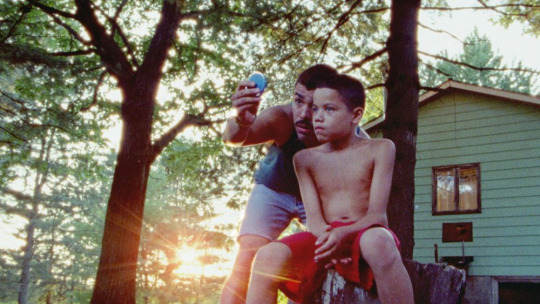
97. We the Animals (Jeremiah Zagar)- The Tree of Life is one of my favorite movies, and on its face, We the Animals is a really similar impressionistic memory. So why do I like it half as much? Are lighting and music that important? Is Jessica Chastain? Is latent racism? All I know is that this felt like a story I had seen before pitched at the same intensity for a running time I was happy to see expire. 96. Kodachrome (Mark Raso)- The three leads are all pretty good. (Ed Harris does this bashful, pulling-on-his-eyelid thing that killed me.) But with mathematical precision, the film matched each element I liked with another thing that infuriated me. Specifically, the whole plot hinges on one scene, and that scene is preposterous and alien to human behavior. 95. Deadpool 2 (David Leitch)- The pacing of these movies is bizarre to me; they're half-over before they really get started. No one else is bothered by the fact that Cable has no motivation or backstory for the first hour? Some of the connections to X-Men felt more forced this time around, but I thought this entry was much funnier than the first, even mixing in some more subtle visual gags. (The exotic locales montage ending in Biloxi really got me.) I have to give credit to the X-Force parachute sequence, which is audacious and unexpected. And clear out for Zazie Beetz, who is a huge star in the making. 94. At Eternity’s Gate (Julian Schnabel)- Something about Van Gogh was essentially unknowable, which is a great reason to make a movie about him and a terrible reason to make a movie about him. I'm not sure that Julian Schnabel got to the bottom of the man any better than anyone else has, though maybe that's an unfair expectation. To his credit, Schnabel yada-yadas the ear business and Van Gogh's death in favor of his more poetic understanding of the artistic life. The movie doesn't coalesce for me, but there's a banger of a scene between Dafoe and Mads Mikkelsen about the responsibility an artist has toward God. That short nested inside makes the whole thing worth seeing. The conversation I had afterwards with one of the two other people in the theater, an art historian, was a solid three stars. 93. Bohemian Rhapsody (Bryan Singer)- Some biographical movies do a good job of compressing time, and their supporting characters don't feel sacrificed or glossed over. For many other mediocre ones though, including this one, I submit the Three Scene Rule. Three scenes is kind of the minimum for a character to register an arc and for an actor to present any kind of dynamic performance, so in a lot of these true story movies, that's all that a supporting character gets. If you're looking for it, it's glaring. (Watch Hidden Figures again with the husband and boyfriend characters in mind. I'll wait.) This movie has a few characters that matter: Freddie Mercury, obvs; the other Queen members; Paul Prenter, the unfairly composited villain; and Mary Austin, the platonic love of Mercury's life. The movie spends way too much time on her, as if to tease the audience with the idea that Freddie might be straight. As for everyone else? Three scenes. Ray Foster, the record executive played by Mike Myers (!): A. "Look, guys, I like formulas. This opera stuff you're talking about? That sounds crazy." B. "The opera stuff is crazy. I ain't making that the single. You can walk out of here for all I care." C. [hangs head in shame after being proven wrong] Jim Hutton, Freddie's partner for the seven years this movie doesn't care about: A. "Look, pal, I may be a waiter, but you can't just grab me like that. On second thought, let's talk. You should learn how to love yourself." B. "Oh, hey. Glad you tracked me down, slugger. You love yourself now? Sure, let's go meet your parents." C. "Guess I'm your boyfriend now. Looking forward to the show." Freddie's Parents: A. "You go out every night! What are you doing out there? Why can't you be a good boy? What's up with your new name?" B. "Why can't you be a good boy? What's up with your new name?" C. "You're a good boy, I guess, even if you're gay. Guess that's your name for real." I like the idea of reproducing the Live Aid performance in full, and the movie comes alive during its musical sequences. But I wish that the same attention given to, like, the number of Pepsi cups on the piano was also given to the nuts and bolts of the storytelling.
92. The Predator (Shane Black)- I get why other people don't like this. The final fourth feels obligatory, and it seems cut to the verge of incoherence. But if you don't get a little tingle out of a game cast saying Shane Black things like, "Predators don't just sit around making hats out of rib cages," then we are very different moviegoers.
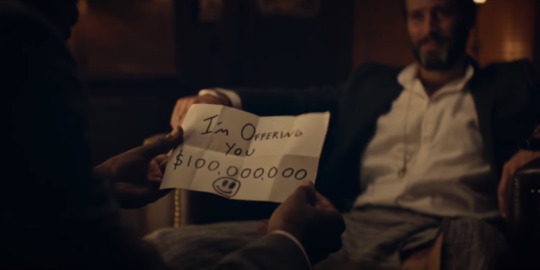
91. Sorry to Bother You (Boots Riley)- I admire Boots Riley's ambition, the way he's taking many of the ideas that drove his music and channeling them into film. But there are too many ideas and, strangely, too much plot to cohere. I liked some of the jokes, especially the Robocop-py TV clips laced throughout. I think my main problem, however, is Lakeith Stanfield as Cassius. He's a fascinating actor, but his energy is completely wrong for an everyman lead like this. I don't think he was the right choice to carry it. 90. Thoroughbreds (Cory Finley)- The repartee at the beginning is sharp, and there are some engaging elements of style. God knows I've never complained about rich, sad, nubile brunettes with strange eyes. But there are pieces missing in that forest-for-the-trees way that happens sometimes with debuts. Like, how do these privileged girls not have access to a gun when our national nightmare is based on all young people having access to guns? Or what is the exact motivation behind the crime at the center? Lots of great characters have been spurred by a violent curiosity, but a zinger here and there doesn't make these girls Raskolnikov. 89. White Boy Rick (Yann DeMange)- Even if this isn't it, I think Yann Demange has a great film in him. There's some urgency to White Boy Rick's politics, and it looks interesting. If nothing else, it succeeds in making the surroundings seem as gloomy as the characters all acknowledge them to be. But this isn't a great film in either of its halves. It's motivated by plot until a crucial event that I don't want to reveal, then it veers much more into character. I would normally sign off on that, but this movie grinds to a halt in the change and never recovers. McConaughey pulls his weight, but Richie Merritt is pretty bad in the lead. 88. The Strangers: Prey at Night (Johannes Roberts)- Despite some striking images and a welcome lack of explanation for the menace, Prey at Night doesn't reach the heights of its predecessor, mostly because the characters are too paint-by-numbers. 87. Ant-Man and the Wasp (Peyton Reed)- Probably the first Marvel movie that would benefit from more action. Some of the material is genuinely funny thanks to Michael Pena and Randall Park, but I got a little drowsy during the middle hour of talk about phase-shifting and the quantum realm. Get back to making things big or making things little, Dr. Molecule! 86. Creed II (Steven Caple Jr.)- The pieces are there, but it's a problem when Jim Lampley, who has one hundred times as many lines as the fifth lead, explains to the audience what they literally saw an hour earlier. If nothing else, this movie proves, through his absence, how good of a director Ryan Coogler is. I would be lying if I said I didn't get the chills at some key moments. Stallone’s performance and Jordan's muscles are good. But there was a dark, honest way for this movie to end, and it went directly against that ending into something more Hollywood. 85. Let the Sunshine In (Claire Denis)- Like Taxi Driver if Travis Bickle just wanted the guy to get him a glass of water afterwards. The film does have that kind of myopic focus--the sexy, ever-candid Binoche is in every scene--but it's far more elliptical, progressing only through character, never through plot. Let the Sunshine In is unique in a way that is different from Denis's other unique works: No one talks like an actual person, and she acts as if you should know all of the characters instead of properly introducing them. It's not supposed to be funny ha-ha, so excuse me if that's what I wanted.
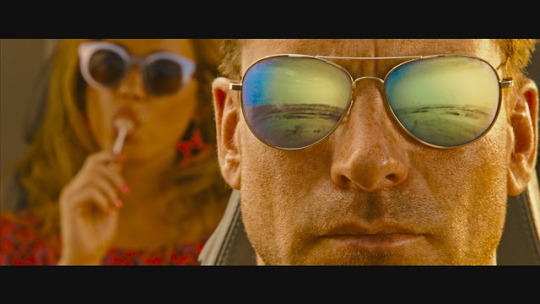
84. Revenge (Coralie Fargeat)- like the style of this film, the color palette, the synth score, how far it's willing to go with the gore. But if it's called Revenge, and it's clear who the hero is (hint: not the rapist), then the whole thing feels like a fait accompli. We know exactly who's going to be the last woman standing, and we even know the order of the people she's going to kill.
PRETTY GOOD MOVIES 83. The Rider (Chloe Zhao)- This movie is trying to be a poem, but the parts I like the most are prose. It's a promising piece of filmmaking with heartbreaking moments, but I found it most effective when the storytelling spelled things out. It's an all-hands-on-deck independent film, so the amateurism of the piece shines through in the performances from non-professional actors. The relationship between Brady and his autistic sister is interesting because she speaks with that sarcastic cadence that can be learned from only children's programming. It's unlike what we usually see because, you know, she's a non-professional actor and real autistic person. So what do I know? 82. Unfriended: Dark Web (Stephen Susco)- Pretty tight from a storytelling standpoint and definitely grisly enough to get under the skin. But these laptop flicks move with such alacrity that it's hard to believe them whenever they ask you to buy something like love, since they paint it with the broadest strokes imaginable. Not that I would want a two-hour version of this anyway. 81. Juliet, Naked (Jesse Peretz)- Charming enough, arriving at a more realistic place than I expected, Juliet, Naked does nothing to make me revoke my charter membership in the Rose Byrne fan club. What an odd shape this film has though. The inciting incident happens at the hour mark, and it races obligatorily to an ending at an hour, thirty-seven. 80. Ocean’s Eight (Gary Ross)- It sets its marks and hits them adequately, with most of the charm that made the other Ocean movies fun. But there's something lifeless about Ocean's 8, both in the direction and the score. Take, for example, Richard Armitage's bland, sort of lost performance as an old flame/mark. It's such a nothing part that I began to think that it was a thesis: The men are just chess pieces, and they shouldn't take attention away from the women this time. But then James Corden emerges in the last half-hour and shines. So maybe Armitage was just bad and directed poorly? This movie exists for the Movie Star interplay though, and it delivers on that level. Cate Blanchett was good for so long that she's popular, and Sandra Bullock was popular for so long that she's good. Rihanna has to dress like a janitor at one point as a disguise, and she proves how absurd it would be for her to ever blend in. Anne Hathaway is the funniest of the bunch, balancing on a highwire of how big she's supposed to seem. Helena Bonham Carter gets the "and" hammer for all my credit fetishists. 79. Mary Poppins Returns (Rob Marshall)- I saw this on Christmas night with my family. The original Mary Poppins was the first movie my mom ever saw in theaters, and it's probably my wife's favorite. To the extent that insulting it is kind of insulting an important part of who she is. So I couldn't be the guy coming out of the theater like, "The Bankses definitely deserved to lose their house." Between you and me though, it's just fine. Entire sequences could be cut without damaging anything--do we ever come back to the bowl that Meryl Steep is supposed to be mending?--and most of the conflict feels manufactured. These legasequels always end up feeling like boxes being checked. We all know that the guys with the cannon had to come back, right? But some of the numbers are so joyful or stirring that even this grinch snuck a few smiles at his daughter as she pointed to the screen and said, "That's so silly." It's a good movie to see on Christmas night with your whole family. 78. RBG (Betsy West, Julie Cohen)- This movie is designed to make the viewer who would seek it out go, "What an American hero." It does that, I suppose, and there isn't a whole lot wrong with it. Yes, she is a very impressive person. But the film has too much untapped potential and too few teeth to recommend beyond that rubric of achieving its goals. For example, what about half of the population that would sneer at the notion that Ruth Bader Ginsburg is an American hero? Besides the inclusion of some radio clips over the credits, the filmmakers aren't concerned. "Look, she was friends with a conservative!"

77. Searching (Aneesh Shaganty)- Since I've seen thousands of movies that don't take place inside of a computer, there's still some novelty to the handful that do. On one hand, there are four or five twists too many, and the film isn't consistent with its own rules. On the other hand, it gets intriguingly dark for PG-13, and it never stops moving. 76. Uncle Drew (Charles Stone III)- The attitude toward women is retrograde, and to call the plot cookie-cutter would be an understatement. But this works, mostly because of the sunny, natural performances. Kyrie Irving, whose handles are even more of a marvel on a forty-foot screen, has to act through pounds of makeup, but he pulls it off. With only commercials to his name, he has to carry scenes of, like, standing at someone's grave and apologizing, and he has the presence and confidence to do it. I also should mention that Nick Kroll has a nothing-to-lose, galaxy brain performance for which probably zero of the lines were written ahead of time. "Shout-out to Oberto, shout-out to Aleve, the number one pain reliever in the game right now." I have to extend some of the credit here to Charles Stone III, who has made a calling card out of coaxing performances from newcomers. 75. Christopher Robin (Marc Forster)- Cute. 74. Unsane (Steven Soderbergh)- What seems to be a B-movie hitting its marks gets elevated by one fantastic scene that makes it seem timely and vital. I can't help but think Steven Soderbergh is punching below his weigh class though. I'm glad that an experiment like shooting a movie with an iPhone gets him up in the morning, and I know he doesn't want to make another Traffic or Out of Sight. But maybe, here's an idea, audiences might? 73. 22 July (Paul Greengrass)- The first thirty minutes are harrowing, in part because of their disciplined cross-cutting and Anders Danielsen Lie's chilling stoicism. The mistake that Greengrass makes is thinking that, later on, the three strands of story are equal in importance. He cuts away from the court case at its apex to see a kid trying to walk again or a prime minister demanding that his administration get tougher. Some moments are powerful, and Greengrass's composition and editing have mercifully softened, but this becomes a grind at a certain point. 72. Solo: A Star Wars Story (Ron Howard)- I hate to state the obvious, but this feels like multiple movies stitched together because that's exactly what it is. On one hand, we have the foggy opening, featuring an airtight inciting incident and setting up Emilia Clarke as that rarest of things in a Star Wars movie: a character with unclear motivations. But as the film goes on, it reveals why Han doesn't work as a protagonist. (Ehrenreich is bad, but the storytelling sinks the movie more than his performance does.) Everyone else in the movie drips with charisma and comments on the action while Han is left to connect the dots. In other words, the other characters get to be Han Solo, and Han Solo doesn't. By the time we get to the marauders, past the two hour mark of a movie that shouldn't have been more than two hours, the narrative crumbles under its own weight. These movies are way too competent to fail--I can list five or six moments that transcend the flaws--but each of these origin stories has a way of erasing the myth of Star Wars with a pen. 71. Bird Box (Susanne Bier)- This is a genre film that you've seen before in one way or another, so your expectations (and filmgoing experience even?) will dictate what you think of it. There's a metaphorical reading available, but that doesn't make the picture more artful automatically. Trevante Rhodes is a Movie Star. Here's what I can tell you: We need to appreciate John Gavin Malkovich while we can. Delivering the apotheosis of the selfish dickhead survivor character, he a) asks why the group can't stay in the grocery store forever, b) points shotguns at people when they try to let in strangers, c) drinks as he's telling people matter-of-factly that this is the end of the world, and d) (sort of) explains why he is the way he is. And-he-does-it-all-with-the-deliberate-cadence-that-you-are-doing-in-your-HEAD-right-NOW. I'm not saying the guy should win Best Supporting Actor or anything, but I admire his career more than any that would get a Best Supporting Actor.
2 notes
·
View notes
Text
Best New Horror Movies on Netflix: Spring 2018
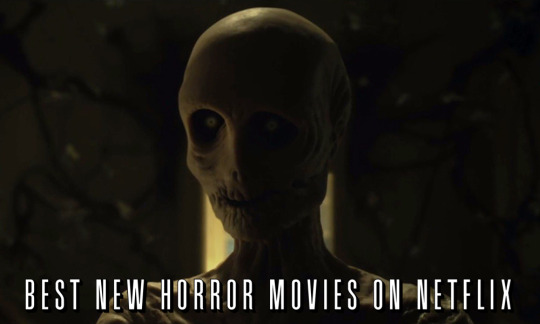
There’s an overwhelming amount of horror movies to sift through on Netflix, so I’ve decided to take out some of the legwork by compiling a list of the season’s best new genre titles available on Netflix’s instant streaming service.
Please feel free to leave a comment with any I may have missed and share your thoughts on any of the films you watch. You can also peruse past installments of Best New Horror Moves on Netflix for more suggestions.
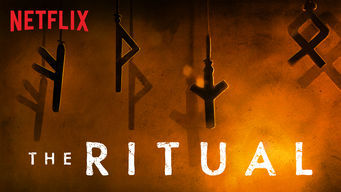
1. The Ritual
The Ritual is the great Blair Witch Project sequel we never got. Although not found footage, it explores many similar plot points as the recent Blair Witch - yet it feels far more fresh and, more importantly, scarier. The first two acts are superbly eerie, and, while it loses a tiny bit of momentum toward the end, it offers a truly imaginative creature design. After memorable segments in several anthologies, David Bruckner's (V/H/S, The Signal) feature directorial debut offers a small but strong cast led by Rafe Spall (Prometheus), well-developed characters, a creative use of flashbacks, and a brilliant atmosphere of dread.
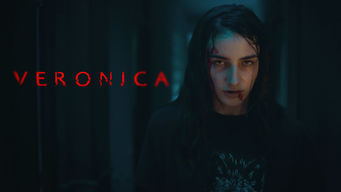
2. Veronica
Veronica's reputation precedes it, as it has been the subject of several high-profile articles touting it as the scariest movie on Netflix. I'm not sure it lives up to that claim, but it's certainly worth seeing for yourself. Based on true events, the film takes place in 1991 Madrid. When 15-year-old Veronica (Sandra Escacena) attempts to contact her deceased father with a Ouija board alongside two fellow Catholic schoolgirls, she becomes haunted by something from the other side. Escacena - an actual teenager - delivers a great performance, and director Paco Plaza ([Rec]) channels James Wan in his expert crafting of frightening set pieces.

3. Before I Wake
Nearly three years after it was supposed to open in theaters, Before I Wake was rescued from rights issues by Netflix. Director Mike Flanagan (Ouija: Origin of Evil, Gerald's Game) has since cemented himself as a modern master of horror, and Before I Wake is another winner. Kate Bosworth (Superman Returns) and Thomas Jane (The Mist) star as a couple who, still grieving the death of their young son, adopt a 6-year-old boy, Cody (a then-unknown Jacob Tremblay, Room). Upon learning that Cody's dreams manifests themselves in reality, the parents encourage him to dream about their deceased son in order to spend more time with him. Unfortunately for everyone, Cody also suffers from nightmares about a creature he calls The Canker Man. It's a bit heavy on exposition, but the film has ample heart and strong visuals. Similar to the work of Guillermo del Toro, Before I Wake blends horror motifs with fantastical and dark dramatic elements.
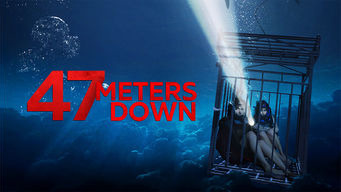
4. 47 Meters Down
Originally scheduled to go straight-to-DVD in 2016, 47 Meters Down was given a theatrical release last summer, which proved to be an unlikely success. Mandy Moore (This Is Us) and Claire Holt (The Vampire Diaries) star in the underwater thriller as sisters whose shark diving expedition goes wrong. Trapped on the ocean floor, the girls' air supplies are quickly depleting while a swam of great white sharks circles the area. There are a few unfortunate jump scares, and suspension of disbelief is certainly required, but director Johannes Roberts (The Other Side of the Door) takes a mostly grounded, serious approach, crafting a bit of old-fashioned suspense at a brisk pace. Read my full review of the film here.
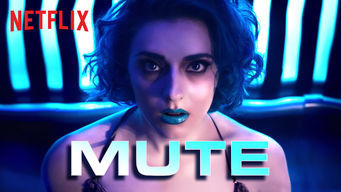
5. Mute
Mute is a sci-fi mystery, not a horror movie - although it does have a brutal kill at its climax. Aesthetically, the film is total Blade Runner worship - perhaps even more so than Blade Runner 2049 - so it is gorgeous to look at. Set in the near future, the plot finds a mute bartender (Alexander Skarsgård, True Blood) searching the seedy underbelly of Berlin for his missing girlfriend. But it's the B-story - in which Paul Rudd (Ant-Man) and Justin Theroux (The Girl on the Train) play a pair of wise-cracking black market surgeons - that steals the show. Director Duncan Jones (Moon, Source Code), who co-wrote the script with Michael Robert Johnson (Sherlock Holmes), also throws in a fun nod to Moon that sets Mute in the same universe.

6. Nails
Nails occasionally feels like a lesser Insidious movie (particularly Chapter 3, since both involve injured female antagonists), but it'll hit that sweet spot when you're browsing Netflix for something short (only 85 minutes!) and creepy in the middle of the night. After a nasty hit and run, Dana (Shauna Macdonald, The Descent) is left confined to a hospital bed, barely able to speak or move. She believes someone is in the room with her at night; at first, she feels a presence watching her, and then it starts touching. Her family and doctors dismiss her claims as hallucinations from painkillers. It suffers from a bit too much exposition, but there are some strong horror set pieces. The Irish film earns bonus points for being almost entirely contained to the hospital bed without getting stale.

7. Ravenous
Ravenous (also known as Les Affamés) is yet another post-apocalyptic zombie thriller in the vein of The Walking Dead, but it's better than many of its contemporaries. The Canadian production is in French, but it addresses universal themes in its exploration of human drama. In the film, various rogue survivors band together to strengthen their chances of survival among the hordes of infected. Along the way, it introduces a mysterious ritual of sorts that the zombies perform, though it's never fully paid off. Nevertheless, this one is worth a watch if you’re a fan of recent zombie dramas like Maggie, The Cured, Here Alone, and What We Become.
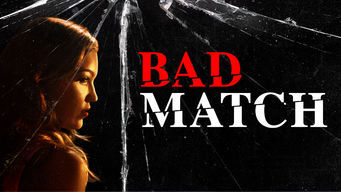
8. Bad Match
The first act of Bad Match resembles a sophomoric “bro” comedy, but it's worth sitting through to watch it blossom into its final form: Fatal Attraction for the digital age. Jack Cutmore-Scott (Deception) stars as Harris, a 20-something tech worker with a tendency to hook up with women from a Tinder-like dating app and then never speak to them again. He finally meets a woman he really likes, Riley (Lili Simmons, Bone Tomahawk), only to have her become deeply obsessed with him. The supporting cast includes Noureen DeWulf (Anger Management), Chase Williamson (Beyond the Gates), Brandon Scott (Channel Zero), and Trent Haaga (Citizen Toxie: The Toxic Avenger IV).

9. Godzilla: Planet of the Monsters
I'm surprised it has taken this long for Toho to make a Godzilla anime, as both are staples of Japan, and the medium eliminates any limitations caused by having an actor in the rubber suit. Godzilla: Planet of the Monsters is the first installment in a planned anime trilogy. Like many Godzilla films, it spends a tedious amount of time with character exposition before the creatures are introduced. The film is set in 2048, after giant monster attacks have caused the earth to collapse. Humans search space for an inhabitable planet before returning to earth; nearly halfway through the movie, they finally land and start fighting the kaiju. It's an impressive sight when Godzilla finally shows up, as it’s the biggest version of the king of the monsters ever put on screen. With all of the set up out of the way, Planet of the Monsters sets the stage for the next two installments to be even better.

Bonus: The End of the F***ing World
The End of the F***ing World is a British series released in the US as a Netflix original. 17-year-old James (Alex Lawther, Black Mirror) is fairly certain he's a serial killer, but when his would-be first victim, the moody Alyssa (Jessica Barden, The Lobster), invites him to runaway with him, the unstable couple fall for one another. Like Natural Born Killers meets Moonrise Kingdom, their time on the road includes absurd crime, unlikely death, young love, and pitch-black humor. With an engaging story spread out across eight 20-minute episodes, it's virtually impossible not to binge through the entire season in one sitting.

Bonus: Haunters: The Art of the Scare
Haunters: The Art of the Scare is ostensibly a documentary about homemade haunted houses, similar to The American Scream. It profiles a few mom-and-pop haunts, illustrating the communal aspect as well as the strain it can have on personal relationships. But the bulk of the film is dedicated to McKamey Manor, a nonprofit "extreme haunt" run out of certifiably insane guy's house in San Diego. There's a waiting list of thousands of people who are more than willing to be debased on camera for all the internet to see. Deplorable as it may be, it's a fascinating subject that, frankly, should have been the sole subject of the documentary.
#netflix#the ritrual#veronica#47 meters down#the end of the f***ing world#before i wake#godzilla#mute#nails#ravenous#bad match#haunters#best of netflix#article#list
177 notes
·
View notes
Text
So, I hear you liked TURN.
Apres the Season 4 finale, I know there’s going to be a lot of crying, and hand-wringing, and rewatching, and these are all good and proper things to do in the wake of a TV show you’ve enjoyed.
But after the smoke clears from all of that, you’re maybe going to go looking for your next 18th century fix, just something in between rewatches or while you’re trying to flesh out your next story idea. (Hey, now that we have our canon, go hog-wild on story ideas, guys, seriously.)
So I’ve saved you some trouble and made you all a helpful list.
Obviously there are a lot of movies and TV shows out there - this is just a selection that I wish more people knew about.
Note: Everyone enjoys a show or movie for different reasons. These shows are on this list because of the time period they depict, not because of the quality of their writing, the accuracy of their history or the political nature of their content. Where I’m able to, I’ve mentioned if a book is available if you’d like to read more.
Before we get to the rest of the list, there are three excellent shows that are either currently on television or about to be very soon:
Poldark (BBC/PBS) is based on a series of books by an author named Winston Graham. It was made into a PBS series in the 70s starring Robin Ellis as the handsome Captain Poldark, who returns from the American Revolution to find his family farm in tatters and his long-time love interest married to his cousin. Drama ensues. The 70s series is worth your time, and the recent remake with Aidan Turner in the title role is also definitely worth a go. (If you like leading men who make terrible life decisions and the women who put up with them, this is totally your show.)
Harlots (Hulu) - If you really loved the TURN ladies, thought Lola and Philomena deserved more than they got, or are just interested to learn more about what life might have been like for the lower classes in London in the 1750s, have we got a deal for you. Harlots follows the lives of 18th century sex workers in this new drama, which was just recently renewed for a totally deserved second season. Female-lead ensemble drama. A little violent at points and deals with some pretty heavy-duty topics like rape, murder, and bastardy, but in a humane and understanding way. Totally bingeable.
Outlander (Starz) - Based on the wildly popular series of books by Diana Gabaldon, this time traveling drama jumps between a couple of different centuries and follows the story of Jamie and Claire, two very strong personalities trying to literally find their place in history. (Hewlett talks about the blade his grandfather picked up at Culloden; that battle forms a critical part of this show’s storyline.) It’s a real pretty show with very high production values.
And, without further ado, the rest of the list!
John Adams: If you haven’t watched this already, do yourself a favor and go pick it up from the library. Starring Paul Giametti in the title role, this HBO miniseries follows John Adams’ role in the formation of America, through his early days in Congress up through his own presidency. As with any biographical show, characters that we know and love from other media (Rufus Sewell’s Hamilton comes to mind, but see what you think of David Morse’s Washington, too) are presented in a slightly different light and provide some food for thought about how history can be selective in how it remembers us. The costuming is great, the sets are fantastic, and the acting is first-rate.
The Patriot: An oldie but a goodie. Mel Gibson plays a highly fictionalized version of Francis Marion, the Swamp Fox while Jason Isaacs turns in a really stellar hottie we love to hate in Colonel Tavington. A little heavy-handed at times, this is a good movie to laugh over with friends.
Sons of Liberty: I’ll be really honest - for a show from the History Channel, the history on this show is pretty awful. But the cast is pretty. This one’s up to you, really. It fills a hole.
Garrow’s Law: William Garrow was a barrister and a pioneering legal mind in the 18th century, and this show (which ran for 3 seasons) is based on real Old Bailey cases and Garrow’s defenses, while also working in his fraught social life. Were you interested in learning a little more about Abe Woodhull’s erstwhile legal training? This is the show for you.
City of Vice: A miniseries that explains the origins and work of the Bow Street Runners, one of London’s first police forces. Does a great job of opening up some of the early 18th century underside of London including a smidge of 18th century gay culture.
A Harlot’s Progress: William Hogarth was an 18th century artist, printmaker and social commentator whose “A Harlot’s Progress” famously depicts the downfall of a woman who goes into prostitution. This 2006 series explores the relationship that inspired the ‘Harlot’ piece.
The Incredible Journey of Mary Bryant: At around the same time America was busy trying to figure itself out, halfway around the world another one of Britain’s colonial possessions - Australia - was just getting started. Hundreds of convicts found themselves stuffed in ships and sent to the other side of the world - a sentence deemed almost more humane. This 2005 series with Romala Garai follows a very famous convict, Mary Bryant, and her experiences.
Banished: Another take on penal colonies in Australia. Currently available on Hulu.
Black Sails: A more recent offering from Starz, this show explores the backstory of the pirates in Robert Louis Stevenson’s Treasure Island. Lots of great representation issues, a whole lot of ‘how does your story get told’ - and there’s a real big community on Tumblr who loves it and very actively produces all kinds of fic.
Clarissa - Simcoe fans, this one is totally for you. Based on the epistolary novel by Samuel Richardson, Clarissa follows a girl of the same name as the infamous rake Lovelace tries to seduce her. Another look at what how women can be corrupted. Also, for you fandom nerds in the crowd, Lovelace was one of the first characters to inspire fix-it fic. Yes, really! Fix-it fic in the late 1700s. Lovelace is one of the original men for whom the ‘No, really, I can reform him’ trope was created. (Richardson, his creator, was so horrified by this reaction by his fans that he actually revised the book several times to try and make Lovelace even more villainous and irredeemable, with little success. Then as now, women apparently love the idea of a bad boy.)
Amazing Grace - The history of slavery in England and its colonies is complicated and nuanced; this story deals with one of the more famous names from that story, William Wilberforce, and his contribution.
Belle - Based on the true story of Dido Elizabeth Belle, the mixed race daughter of a Royal Navy Admiral. Another look at racial politics in England.
The Aristocrats - One of my all-time favorite TV miniseries and based on the nonfiction book by Stella Tilyard, this show follows the (actual, nonfictional) Lennox sisters, daughters of the Duke of Richmond as they grow up, marry, and adjust to rapid social change from the early 1700s into the 1790s.
The Duchess - About the same time the Lennox sisters were out in society, so was Georgiana, the Duchess of Devonshire. This is based on (I’m not sure how closely) Amanda Foreman’s biography of Georgiana, one of the leading ladies of her day.
Dangerous Liasons - Another story about corruptible young women, this one has 3 very well deserved Oscars to its name and an absolutely stunning Glenn Close.
Barry Lyndon - a very evocative, sumptuous film by Stanley Kubrick. Short on action, but very, very Aesthetic, as only Kubrick can do.
The Scarlet Pimpernel - Based on the book by Baroness Orczy, The Scarlet Pimpernel is largely considered to be one of the world’s first ‘superhero with a secret identity’ stories. Sir Percy Blakeney uses his identity as a dim-witted fop to provide cover for his activities rescuing French aristocrats from the guillotine during the French Revolution. The 1982 version with Anthony Andrews and the 1999 version with Richard Grant are both a lot of fun.
Speaking of the French, where would we be without them? Our small domestic dust-up with Britain has far-reaching international consequences, setting in motion so many other social movements in Europe. The French, for instance, will have their own revolution several years after ours, which, of course, will lead to a total political shakeup ending with an artillery officer named Napoleon Bonaparte on the throne as Emperor. (You may have heard of him. He goes on to have his own series of large wars and, you know, completely changes the geo-political landscape of Europe. Like you do.)
La Revolution Francaise, filmed for the 200th anniversary of the Revolution, is available on YouTube in it’s entirety with English subtitles! Starts in 1774 and goes through the 1800s. C’est merveilleux.
Marie Antoinette - Sofia Coppola’s wild, modern romp through the life of one of the 18th century’s most notorious women. It may not be great history, but darn me if it isn’t fun to watch.
Farewell, My Queen - Another story about Marie Antoinette - this one is in French.
Nicolas Le Floch: An 18th century crime procedural set at the court of Louis XVI. The whole show is in French, so watch with subtitles, but the costumes are a lot of fun and it gives an interesting picture of the life a character like Lafayette would have left behind when he came to America. (He gets name dropped a few times, actually, though he never actually appears.)
Ekaterina: A 2014 miniseries from Russia discussing the rise of Catherine the Great, the Empress of Russia from 1762 to 1796, contemporaneous to the Revolution. The 18th century is a fascinating time in Russian history and Catherine is a really, really interesting lady. Totally go and read about her.
Anno 1790: A Swedish crime procedural set in 1790s Sweden and following Johann Däadh, a doctor recently roped into the police force. Däadh is a bit of a reformer, interested in the rights of man and giving everyone a chance to be heard. Costumes are fun, and there’s a really great slow-burn romance between two of the characters, one of whom is (gasp) married. This show only ran for one season, but it was a really, really good season.
If you’re still jonesing for period dramas after the rest of this list, here’s a lot of shows and tv series set during the Napoleonic Wars that are also totally worth your time - the Richard Sharpe miniseries, the Horatio Hornblower miniseries, the BBC’s War and Peace, Master and Commander, and then, of course, anything based on a Jane Austen novel.
Have fun!
909 notes
·
View notes
Text
Warehouse 13: The 10 Most Powerful Artifacts, Ranked | ScreenRant
Warehouse 13 blended comedy, drama and history to become one of the most unique sci-fi/fantasy series we’ve seen in a while. It followed secret government agents as they secured historical artifacts imbued with amazing and sometimes dangerous powers.
Despite the fact that many of these artifacts looked like regular everyday objects, they were also extremely powerful and valuable. A mug, button or pair of glasses can maim, kill or even destroy the world. Bingeing it now, we can see how ahead of its time it was, so these are the 10 most powerful artifacts on Warehouse 13.
10 42ND STREET FILM MARQUEE

The idea of being in a big Hollywood musical sounds like fun, but in Warehouse 13, it turns out it can be fatal. Once again, Pete’s curiosity gets everyone in trouble when he activates this marquee from the theater 42nd Street premiered at.
RELATED: 10 Recent TV Shows With The Worst Special Effects
An army of showgirls floods the Warehouse, forcing everyone to tap along until they die, or the team can blow out all the bulbs. Thanks to Claudia’s dancing, the team uses other artifacts to destroy the marquee with a big musical finish. As dangerous as it is, this is one of those moments where the team enjoys how great their job really is.
9 ORIGINAL STICKY STRING

Anyone who’s played with sticky string at a party knows that the clean up isn’t always worth the fun. Multiply that by a million and you have the original sticky string from the Warehouse. Not only does it get everywhere, but it also expands, traps and clogs.
It almost destroyed the Warehouse when it was accidentally released in the neutralizing processing center, causing artifacts to come to life, and attack Pete and Myka. Thankfully, the team is able to freeze the string and get the neutralizer back online. We’ll remember that trick at the next birthday party we go to.
8 ANALOG PASSWORD DECODER

Artie has a rotating list of artifacts that he carries in his ever-present bag. One of the regular ones he likes to use is the Analog Password Decoder. We’ve seen him and the agents use it several times during the show’s five seasons. It breaks the password or code of any digital device.
RELATED: All of the MCU's Upcoming Disney+ Series, Explained
When the show premiered in 2009, this was a super cool, cutting edge tool to have. Nowadays, where basically the whole world runs on computers, this would make someone unstoppable, and possibly all-powerful.
7 SYLVIA PLATH’S TYPEWRITER

Kept in the Dark Vault with the deadliest, most dangerous artifacts, Sylvia Plath’s typewriter drains the life from the affected person. It causes a depression that can’t be broken. When the sticky string shuts down the neutralizer pumping through the Warehouse, Pete gets trapped in its spell.
Ultimately, Myka resorts to just pushing Pete out of the typewriter’s containment field to free him, which tells us if someone gets stuck in its path, there’s really no way to convince them to come back from their despair.
6 HARRIET TUBMAN’S THIMBLE
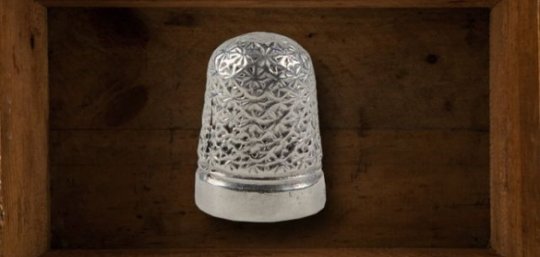
Over the course of the show, some artifacts pop up more than others. Harriet Tubman’s thimble plays a role in a few critical Warehouse moments. Since it has the power to give the wearer the appearance of someone else, it’s often used to trick the agents. However, they occasionally use it to catch bad guys.
For example, H.G. Wells uses it to fool and capture Jack the Ripper, while Myka uses it to impersonate H.G. and finally stop MacPherson. Considering how dangerous this can be in the wrong hands, the thimble is one of the most important artifacts in the Warehouse.
5 HONJO MASAMUNE

This ancient Samurai sword is more than just a beautiful masterpiece. In fact, it’s so perfect, it splits light and makes the user invisible. It first appeared in season one when Pete and Myka were sent to switch it with a replica.
RELATED: 10 Characters we Hope Appear in She-Hulk
The tsuba, another piece of the sword, is what will complete it and make someone invisible. Turns out an invisible criminal mastermind with a sword is an extremely formidable foe. Artie ends up getting stabbed, and the sword is recovered, with a note to keep the two pieces apart.
4 TRIANGLE SHIRTWAIST FACTORY DOORKNOB

There are a lot of artifacts connected to fire, but none are more deadly than the doorknob from the Triangle Shirtwaist Factory fire. Imbued with the pain of the women who fell victim to the infamous disaster, it causes serious burns when touched, and spontaneous combustion with long exposure.
It’s so powerful that neutralizing gloves can’t contain it. The few times we see it, it’s being used by evil agents to torture someone. Once the team bags it in the current timeline, it stays in the Warehouse, hopefully in the Dark Vault.
3 SPINE OF THE SARACEN

In “Burnout,” the Spine of the Saracen highlights just how dangerous it is to be a Warehouse agent. The Spine attaches to a person, then uses their electrical impulses to enhance speed and strength, essentially making them a superhero. Unfortunately, it also fills them with anger and they go on violent rage sprees.
RELATED: Supernatural: 10 Hidden Details About the Main Characters Everyone Missed
Pete and Myka come across it when they find the body of a former Warehouse agent. While chasing the artifact, it attached itself to him and he sealed himself off, so no one else would be infected. Pete and Myka finally destroy the Spine, giving his former partner some closure, but it’s a sad victory.
2 DARK VAULT

There are some artifacts so awful they can’t be kept in the regular Warehouse. These are stored in the Dark Vault, where each has its own containment field. Since the artifacts affect a person’s mental state, it’s the most secure section of the Warehouse.
Though we never found out what many of the objects do, some of the more fascinating inclusions are William Shakespeare’s chair, Miles Davis’ first trumpet, and ruby slippers, that click three times and have a witch’s laugh.
1 JOHANN MAELZEL’S METRONOME

The metronome became the most important artifact in the Warehouse when Claudia used it to bring Steve back to life. As long as the metronome ticked, Steve lived. An unfortunate side effect meant Claudia would suffer Steve’s pain until they could break the spell.
In the end, he had to start fresh with a pure heart, meaning he had to let go of an old hurt between him and his mom. Once Steve destroyed the metronome to save his mother, he was free from the connection. Though Steve was a late addition to the team, we really liked him and was glad they found a way to keep him in the Warehouse.
NEXT: The Matrix 4: 5 Fan Theories That Are Too Crazy To Work (& 5 That Could Actually Happen)
source https://screenrant.com/warehouse-13-powerful-artifacts-ranked/
0 notes
Text
Reflections on “The Mirror”
I love Tarkovsky’s films for many reasons. His long takes canvas the images and environment of the landscape and allow for thorough inspection. His films always contain many references to popular artworks and thus serve as an excellent study for art enthusiasts and aspiring cinephiles alike. Every frame’s placement and aesthetic depiction is significant. Not a moment is wasted.
In The Mirror, just as in Ivan’s Childhood, we see the appearance of an art book which displays some reproductions of the works of Leonardo da Vinci. Da Vinci, who often considered the apex of high Renaissance, had a growing significance in Tarkovsky’s life. In addition to Robert Bresson, Johann Sebastian Bach, and Leo Tolstoy, he was one of the personalities who influenced him until his dying day. In the flashbacks to his youth, Alexei is displayed as a child who browses this particular art book; the partialities of someone else are indicated by inserted dried tree leaves, for instance at the studies towards ‘The Last Supper’.
Probably the most prominent role in the film is Da Vinci’s ‘Ginevra de’ Benci’, which was acquired by the National Gallery of Art in Washington D.C. and is therefore the only painting by Da Vinci in a collection outside of Europe. In his book, Tarkovsky describes the ambivalence of the impressionable impact of the portrait in his own urgent words as “inexpressibly beautiful and at the same time repulsive.” (Sculpting in Time: Reflections on the Cinema, Page 108). “This Portrait is needed in order to introduce a timeless element into the moments that are succeeding each other before our eyes, and at the same time to juxtapose the portrait with the heroine, to emphasise in her and the actress, Margarita Terekhova, the same capacity at once to enchant and to repel.” The lasting fascination lies in the fact that these very different moments cannot be taken separately. In the film, there is a moment when Johann Sebastian Bach’s recitavito “Und siehe da, der Vorhang im Tempel zerriss in zwei…” plays, presisely when the homecoming soldier and father is holding his son and daughter in his arms. In the Gospel According to Luke, the curtain (Vorhang) is meant to seperate the Holy from the Most Holy Place; thus, the Most Holy Place became visible to us.
This brings me to the conclusion that the film itself becomes the mirror; because the viewer does not accept the ambivalence for a continuance, one has to decide upon one’s own interpretation of the expression—thus, the film is intended to reflect one’s own reality. One gets the impression that Tarkovsky’s conception of art is dialectical in nature, which led him to violate the harsh limitations placed on visual art in the Soviet Union, which at the time restricted any imagery that contradicted Soviet foreign policy. He wanted his art to depict life as a whole without being subject to the conditions of the state. At last, Tarkovsky managed to retain this tendency against partiality inside the composition of his pictures. Perhaps that is why, to this day, Tarkovsky’s last film The Sacrifice, has often been interpreted as a plea for Nietzsche’s ‘Will to power’ or ‘Eternal recurrence.’ As it is written down in the Gospel According to John: “For if we would judge ourselves, we should not be judged.” (1 Corinthians 11:31)
Another scene in the film is about the paramilitary training of young boys during the war at firing range. One of the boys, Asafiev, refuses to follow orders from the instructor. I believe that this boy might be a survivor of the Siege of Leningrad, which, alongside the Spanish Civil War and Mao’s attack on the Russians, is part and parcel of the structure of relationships between wife, husband, mother, father, and son. He succeeds in putting the instructor and his comrades in fear and distress by throwing the dummy of a hand grenade with intent to let them participate in his traumatic experiences. As the dummy rolls over the floorboards, everyone throws themselves to the ground. By trying to catch the grenade, the instructor loses his cap and some kind of protective plastic cover. Apparently, he is missing a piece of the cranial vault, and we see a throbbing pulsation beneath the scar covering his head. The cold and hard-hearted man suddenly appears vulnerable and defenseless. The general pity of which Tarkovsky occasionally spoke is revealed to us—for example, in the interview for Nostalghia: “I wanted to speak about that which is called ‘nostalgia,’ but I mean the word in its Russian sense, that is to say, a fatal disease. I wanted to show psychological traits typically Russian … The Russian term is difficult to translate: it could be compassion, but it’s even stronger than that. It’s identifying oneself with the suffering of another man, in a passionate way.”
Subsequently, we see this unfortunate boy in front of a Winter landscape vivified by people. This scene is often referred to the Brueghel painting ‘The Hunters in the Snow’, which had been shown in Solaris . Tarkovsky himself announced that he had sought the immediate proximity to Brueghel in this scene: “Again in The Mirror, take the shots of the episode with the military instructor. There are two or three that are clearly inspired by the paintings of Brueghel: the boy, the tiny figures of the people, the snow, the naked trees, the river in the distance. I constructed these shots very consciously. Almost deliberately. And not with the idea of stealing or to show how cultured I am, but to testify my love for Brueghel, my dependency on him, the profound mark that he has left in my life.” [1]
But I would like to emphasize another relationship that was important to Tarkovsky and which is less obvious. In one of his books, ‘Sculpting in Time’, he speaks of the many-figured pictures of the Venetian painter Vittore Carpaccio. As the special feature of his art, he emphasized the fact that each and every single person in them could be the subject of the whole image. Perhaps he saw something similar in Brueghel since this is exactly what seems to be happening in this scene: a sparrow takes flight and settles down on the boys head. This might be a poetic indication that he is meant to be remembered, and this also applies to a boy who seems to have refused everything in life. Utilizing the collage technique characteristic of this film, this scene is proximately surrounded by terrifying black and white images of world-historical significance: the corpse of Hitler, an awfully mimeographed bust of Mao, atomic clouds, et cetera. Apparently, it must be understood as the assertion that despite all these terrors, there is still enough attention for the individual.[2]
To me, The Mirror is Tarkovsky’s most personal achievement of Art, for it captures life how the artist remembers: a dreamlike, fragmented and often out of order tragic soliloquy. The brilliant inclusion of his father Arseny’s poems, my favorite of which is First Dates, serves to accentuate the poetic nature of the film. The Mirror is an existential Gesamtkunstwerk, a dialectical unity of life’s serene beauty and immense tragedy. While all of the characters experience melancholic lives, an overwhelming beauty pervades the film. Even with the majesty of the images, a subliminal sorrow always prevails. However, this is not to say the film is pessimistic. In fact, it transcends all dichotomies. In his words, “Artistic creation is by definition a denial of death.”
1. http://nostalghia.com/ Tarkovsky talks to Guerra, mainly on Stalker (1979). 2. “In one form or another all my films have made the point that people are not alone and abandoned in an empty universe, but are linked by countless threads with the past and the future; that as each person lives his life he forges a bond with the whole history of mankind..” (Sculpting in Time, Page 205).
12 notes
·
View notes
Text
Hat 10
This isn't now I intended for this to end. It may not seem like it, but this is actually my 3rd rewrite. I wasn't happy with any of them. Anyway, here you go! *tosses online and runs away*
Part 10 of 10
Genre: Romance....
Pairing(s): Hanzo/McCree
Rating: T
Overall Summary: Hanzo has a theory about McCree's hat until he finds out how very wrong he is.
Chapter Summary: Hanzo finally faces the fact that he has more than friendly feelings for McCree.
Part 1 | 2 | 3 | 4 | 5 | 6 | 7 | 8 | 9
Hat: Part 10
Hanzo decided that he would never show his face around the base again. That would be fine. He could easily get a mercenary job—something a little more freelance—and move into a place of his own. A nice, quiet apartment. Upper floor. No one he knew within a hundred miles. He could quietly go about his day and quietly return home where he could quietly meditate. And he would never have to see or think about the cowboy again.
Yet when he told Symmetra his plan, she laughed in his face. "You are more of a coward than I thought," the architect told him. "And it's all because you don't want to say those three little words. Go ahead and say it. You need the practice."
He was being laughed at once again. What kind of friend was she? "I will not say something like that. Especially to him."
"Not even if it is true? Because it is," Symmetra said. "I'm having a hard time understanding what the problem is, Shimada. The difficult part is already over. You know that he likes you."
"That's not the point," Hanzo told her with a frown. "I am not sure how to explain it.... I have never...." He struggled to find what he wanted to say.
"Never what? Been in love? Well, get over it because you are now."
"I would not say that I am in love."
"Then you admit that you DO like him?" Vaswani asked.
Hanzo knew he was blushing, so he turned away from her. "We had a very disturbing interaction recently. I cannot face him ever again."
"Your definition of 'disturbing interaction' is questionable. You have claimed that every interaction you have with McCree is disturbing in one way or another," Vaswani reminded him.
He should have known better than to talk to her about this. She had no idea how complicated his situation was. During a purely innocent question and answer session, Hanzo had asked McCree a very personal question that was sexual in nature.
The cowboy had said before that he held Hanzo to a higher standard than others, but did he feel the same way after he'd asked that question?
"I can no longer face him. I have shamed myself," Hanzo maintained.
"You are overreacting," the architect said. "And you would not be overreacting like this if you didn't like him."
Hanzo frowned. He'd been considering that he might actually like the cowboy for a while, but that one little statement from Symmetra really opened his eyes. He wouldn't be putting so much thought into it if he didn't have feelings for the man. Hanzo wouldn't feel as if his whole world were collapsing around him if he weren't at least a little interested in him. The archer did have feelings for the gunman and those feelings went beyond friendship. But if it was so obvious to Vaswani, who else was able to see it?
Well, his main concern wasn't other people. Hanzo wondered if McCree himself could see it.
---------------
Hanzo spotted McCree sitting outside writing in his notebook. The archer thought about turning around and walking away. He was still a little nervous about facing the cowboy after making a fool of himself the other day. He never should have asked if McCree had been with men before. But it was already done and now he had to live with the consequences.
The bowman hadn't seen or spoken to McCree since the day the cowboy decided to hug him. Hanzo thought about calling out his name to get his attention, but instead, he just stood there and watched the cowboy write. It was as if McCree were in his own little world. Well, in a way he was. But just watching him concentrate like that on something he only did for fun was pretty fascinating. Maybe this was his form of meditation. Maybe this was another way for him to keep his mind preoccupied. If so, it was a pretty good way to do it.
Hanzo finally called out McCree's name and he watched as that look of concentration transformed into what could only be described as joy. The smile on the gunman's face made Hanzo smile a little. But it was short-lived, however. The archer had interrupted McCree, but he didn't really remember why.
"Hey, Shimada," McCree said, a little more enthusiastically than Hanzo expected.
The cowboy waved him over and Hanzo wordlessly sat across from him.
"There's this thing I'd like ya to read. I was just puttin' some finishin' touches on it," McCree told him.
Hanzo noticed that McCree had the brim of his hat pulled down to cover his face. The gunslinger pushed the notebook toward him and Hanzo started flipping through it.
"It's the last one that'll go in that notebook. I hope ya like it."
"Before I read it, there is something I would like to ask," Hanzo said, fingering the pages of the notebook.
McCree finally looked at him from beneath the brim of his hat. "What is it?"
Hanzo only looked at him for a moment before he went back to staring blankly at the notebook and fiddling with its pages. "You said that the way you write my character in your poems.... Well, you said that you don't see me that way."
"I see what yer gettin' at," McCree said. "The Hanzo I write is kinda cold and he doesn't put a whole lot of thought into the stuff he does. He just kinda does what he does, no questions asked. Things are either one way or another. Right or wrong. Good or bad. Ain't much of a gray area with him." He tipped the brim of his hat back down to cover his face once again. "Yer different. Ya seem to think things over a lot. When we're out on a mission, I can see ya weighin' yer options even in the middle of a firefight. It's amazin' to watch."
Hanzo looked confused. That only meant that the cowboy could see him hesitating. That wasn't a good thing.
"Besides, that Hanzo never misses. I've seen you miss a couple of times," McCree said, a little bit of a laugh on his voice. "You should see yer face when that happens."
So, the Hanzo McCree wrote about was basically perfect while the real life Hanzo had flaws. Of course he had flaws, but he wished that McCree didn't have to point them out. His bow accuracy was well above even those who called themselves professionals. There was no shame in missing a shot here and there.
"Not to mention that he's not shy, but you are," the gunman added.
"I am not shy," Hanzo told him yet again.
"Ya are compared to him. Just read that last poem," McCree said.
There was no need for further argument. Hanzo decided that he should just read the poem. As he was reading, he would glance up every now and then to see if McCree was watching him but he couldn't see anything under the brim of that cowboy hat.
And Hanzo found out why McCree made the claim that he was shy and the Hanzo in his poems was not. The poem was less of a western than the ones that came before it. It was actually kind of a romance and it also featured McCree. It basically replayed the few days up until McCree told Hanzo that he liked him, but with one major difference. Once McCree told Hanzo that he liked him, the Hanzo in the poem had kissed him.
Hanzo quickly closed the notebook, his face tinted pink with embarrassment. He couldn't bring himself to look at the gunslinger. Did McCree think that was what should have happened? Did he think that was what Hanzo wanted to do?
"Yeah, yer too shy to do somethin' like that," McCree said, his hat still pulled low.
The archer knew that McCree was just goading him. To be honest, he hadn't really thought much about kissing the cowboy. Then again, after his chat with Symmetra, he found out that he must have felt something more than friendship for the gunman. And if that were the case, then kissing would surely follow.
He glanced at McCree and found that he was finally looking at him.
"There's that thoughtful look. Weighin' those—" McCree began with a chuckle.
The cowboy wasn't able to finish his statement before Hanzo quickly leaned across the table and kissed him on the lips. It wasn't for long and he'd almost missed, but Hanzo was pretty sure that he'd gotten his point across. "I am not shy," he said quietly as he sat back down.
McCree licked his lips and grinned. "Well, I guess ya ain't."
They sat there quietly for a while and Hanzo wondered if he'd done the right thing.
Suddenly McCree stood and walked over to take a seat right beside Hanzo. "Alright. Ya convinced me. I'll let ya make out with me." He leaned in close and puckered up for another kiss.
Hanzo thought about going along with it, but instead he put notebook between their faces. "Why did I have to be the one to kiss you? Why did you not kiss me?"
McCree moved the notebook out of the way. "Cause I already told ya how I felt. You seem to have trouble with yer words, so I thought this would be easier fer ya."
The archer narrowed his eyes at McCree.
"Besides, I'm shy. I couldn't do somethin' so embarrassin'," McCree added with a grin.
---------------------
epilogue—three weeks later....
"I hope ya don't expect me to remember the names of all this stuff. They all got the same title," McCree said as they listened to their third piece of classical music. "What's this one again?"
"Canon in D major. It is a piece by Johann Pachelbel," Hanzo told him. "Surely you have heard it before."
McCree nodded. "Never knew the name of it, though." He moved closer to Hanzo and grinned. "Seems I remember folks used this song at weddin's." He wriggled his eyebrows suggestively and put his arms around the shorter man. "Somethin' ya wanna ask me?"
Hanzo sighed and rolled his eyes. "It was also played for funerals."
"Hm," the cowboy said, sounding a little disappointed. He kept his arms around the archer anyway. "Yer not plannin' some elaborate proposal, then."
Hanzo chuckled to himself. "Perhaps I am planning an elaborate funeral. I am taking you boating tomorrow, after all."
"Not funny."
5 notes
·
View notes
Text
Earthworld
Some highlights of the last EDA I’ve read (Earthworld).
I took these screens while reading, along with my reactions. As usual, this is full of spoilers.
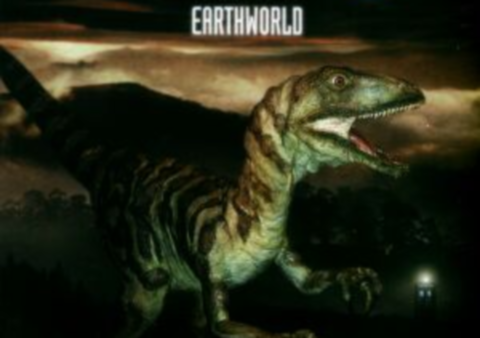
This is exactly what everyone needed after the Earth arc, and especially after Escape Velocity and Anji’s lackluster characterisation. She’s reintroduced in this book, and what a wonderful addition to that TARDIS team! And the book tackles the topic of Dave’s death, where the previous one kinda refused to do so before sending Anji directly into space.
Come to think of it, the book tackles a lot of things it didn’t have to, and succeeds, too. Eight’s responsability in the destruction of Gallifrey constantly threatens to make a comeback in his mind. The issue of Fitz being a copy of the original Fitz is discussed at last - a thing all the books since Interference failed to do properly (including The Ancestor Cell). Come to think of it, Earthworld might just be the best Fitz book so far, which is a baffling thing to me considering that’s his twentieth book!
The plot itself is mostly a good runaround in an amazingly fun setting - it never really threatens to be more than that, but it’s still pretty refreshing. It’s a great standalone book, a fun romp, a very good character piece ; it works on nearly every level. What a breath of fresh air. 8,5/10

My bad, I seem to have picked the novelisation of An Unearthly Child.

We’re only on page one and I’ve already laughed out loud once. Good sign.

I just had a flashback of the scene from Memory Lane where Charley tries to use a mobile phone, and I imagined these two dorks trying to have a conversation over mobile phones and I’m giggling
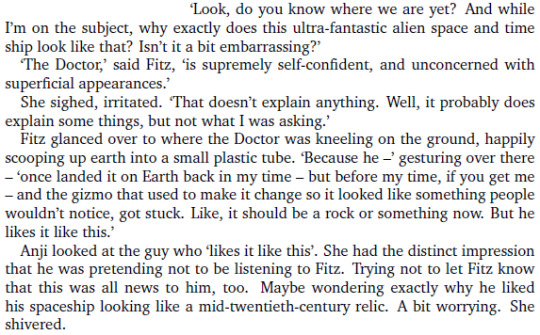
Also Anji thinking Fitz and Eight are embarrassing idiots gives me life

This is a 3 out of 10 on the scale of Bad Ideas.

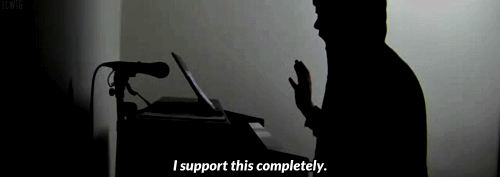

WE’RE ONLY THREE PAGES INTO THIS STORY AND I’VE ALREADY SAID “IDIOTS” THREE TIMES

Oh my god Eight

Thank you for your precious contribution Doctor

FITZ NO

Are you telling me that the Doctor can only use the sonic as long as he’s distracted and babbling about special interests now
Because that really speaks to me as a person

Meanwhile Anji is trying to cope with Dave’s death by writing him emails and this shouldn’t be that funny

Oh no he still has some memories of Sam and he doesn’t realise it

Okay so I need to make this t-shirt right now immediately

One thing I don’t really like about the writing is that some dialogues are entirely one-sided. It’s not the best example, but in some scenes you only get half the dialogue and it’s very strange.

We’re all very happy for you Doctor but why are you so happy about that

OH SHIT HAHAHA that’s a great idea!
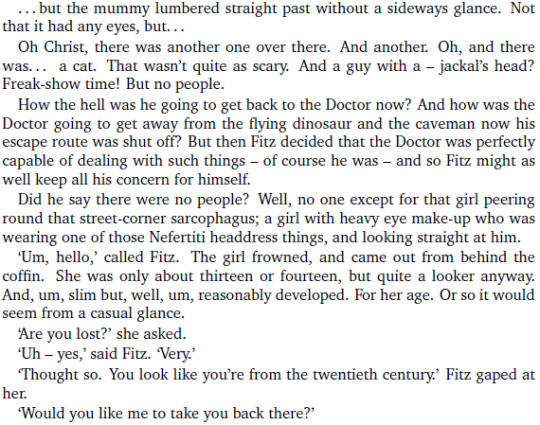
Wait a f█cking second
Is this some sort of Disneyland very loosely based on Earth
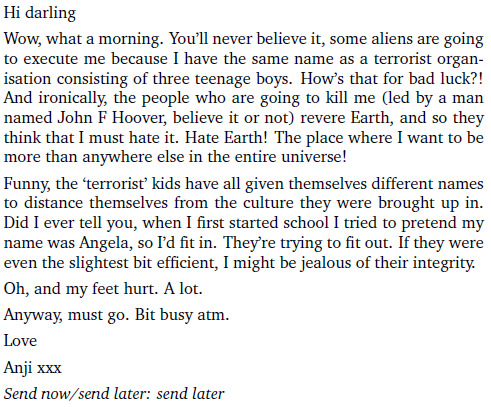
I love you Anji

That girl must be a New Who fan who calls Ten “the second Doctor” probably

I probably should smile but I’m actually sad

That coat has only a few hours left to live & I have zero doubts about this
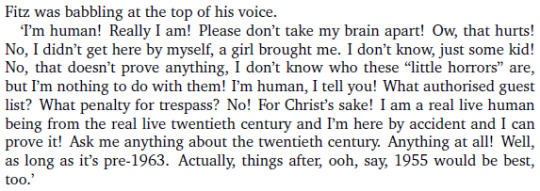
Here’s a better example of what I was saying earlier about having only one side of a dialogue. It makes scenes shorter, true, but it’s very distracting.
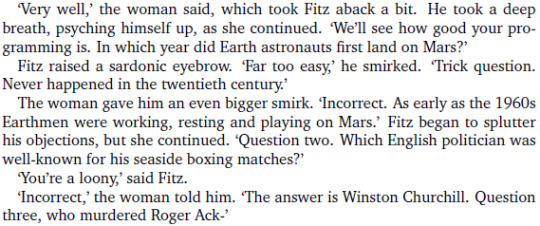
I’m laughing but I’m also pretty sure people from 3000 years ago would laugh their asses off if they could see some of our reconstructions of their lives
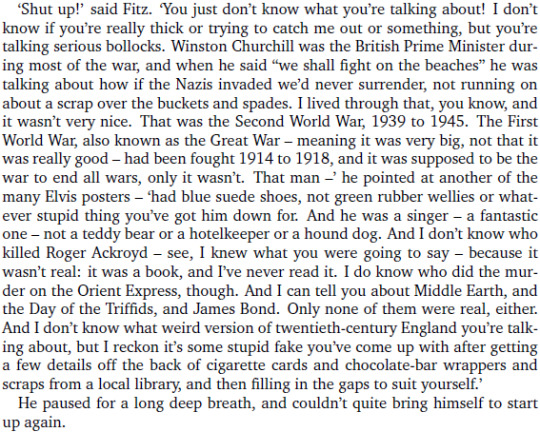
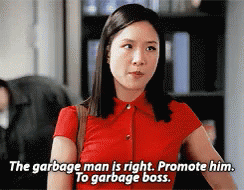

I still love you Anji

1) A++ description of McGann’s voice
2) That last bit was Not Okay
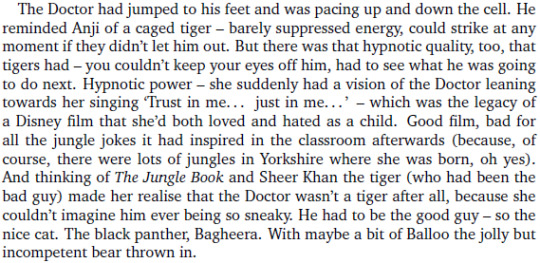
Also here’s Anji trying to determine which Jungle Book character suits the Doctor best and it looks like a long shitpost

First I laughed about Fitz being the orang-utan, and then I remembered that character really wants to be human and I abruptly stopped laughing

You were on Earth and you didn’t see Blade Runner when it came out? Aw

“he mentally kicked himself for not even being able to look at a babe without thinking of the Doctor” I’m screaming



How did you guess

Only every three months?

Considering it’s been 30 books since Seeing I, and taking into account the fact that I almost wrote “TOO SOON”, we can safely assume that I will never, ever be over Seeing I

I absolutely love this conversation, and also sky-blue pink is still a color, just an impossible one, and it’s quite pretty

Holy sHIT TALK ABOUT MOOD WHIPLASH

OH NOOOO, HELP, CUTE

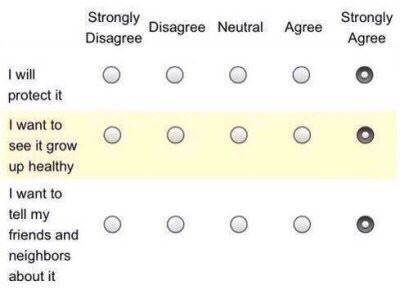

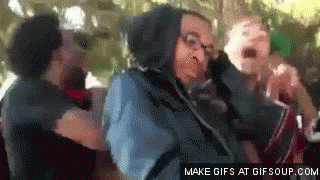

THIS SHOULDN’T BE THAT F█CKING FUNNY

HE JUST SLIPPED IN THE DAMN BLOOD WHY AM I LAUGHING SO HARD
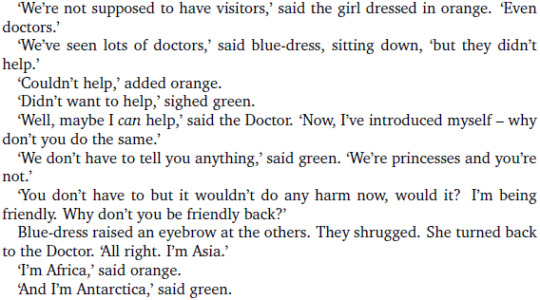
Unfortunately this is what popped first into my mind before the most logical explanation for their names
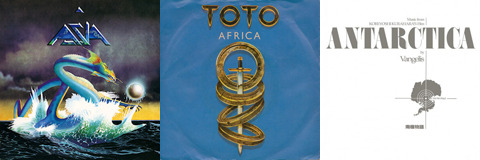

9847221° friendly reminder that I absolutely love Eight

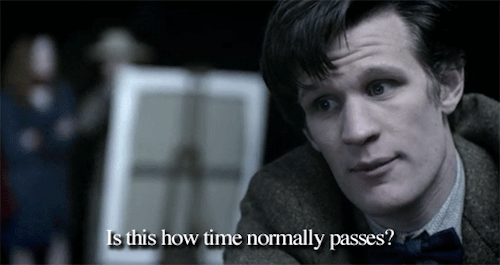

FITZ NO

This book makes me laugh way too often this isn’t fair

Oh the indignity

Fitz no. Just. No.

I just choked on my cereals


1) They think Aristophanes plays are cookbooks and they aren’t even questioning this, like, how does that fucking work
2) Fitz once got trapped in the classical section of the TARDIS library
3) for two days
4) for two DAYS
5) and decided to read old plays just in case there was some sex scenes in them
holy shit
there’s genuine tears of laughter in my eyes

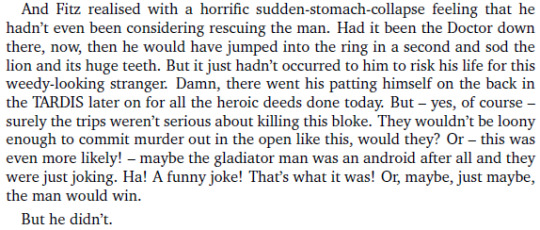
This book is quite the emotional rollercoaster isn’t it

Okay so that explains quite a few things. Fitz is with the originals, then.

THIS IS WHAT YOU GET FOR TRYING TO CONVINCE PEOPLE YOU’RE A ROCK STAR FITZ KREINER

I shouldn’t be laughing so hard

I’m still laughing but I’m also so happy for him

Live the dream, Fitz, live the dream

Well except it wasn’t technically you, except it was, except it wasn’t

HOLY SHIT ARE WE FINALLY GOING TO ADDRESS THIS PROPERLY?!

NOT
F█CKING
ALLOWED
OUCH



Addressing a disturbing trend in SF! Good!

Well to be fair, theropods are sorta like big swans
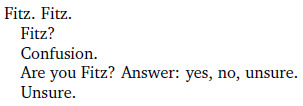

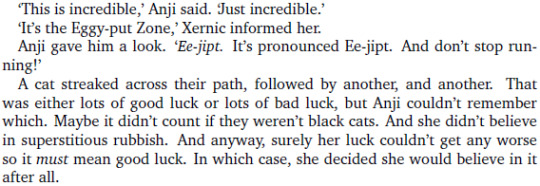
1) Eggy-put Zone
2) Dozens of cats

Hey wait a f█cking second that’s not the same sphinx okay that’s a whole different mythology, also I’m laughing again, this book is probably adding quite a few extra months to my lifespan
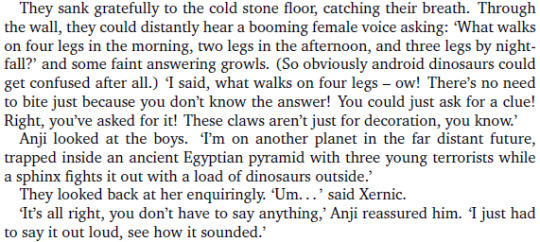
Friendly reminder that I love Anji

Which would definitely work on you, Doctor, just a reminder

Meanwhile, in Not Okay Land

At the moment? Not much

I... sorry there’s a thing in my eye
I’m so happy for him

HA HAHAHA
SPOKE TOO SOON F█CK


Back to a place I haven’t been to in a long time, aka “want to hug Fitz and rock back and forth” street

Meanwhile Fitz is doing the same thing to a small crocodile

STORY OF MY F█CKING LIFE

Listen Eight I'm still not ready for The Turing Test references at this point and you’re making me really sad so please stop
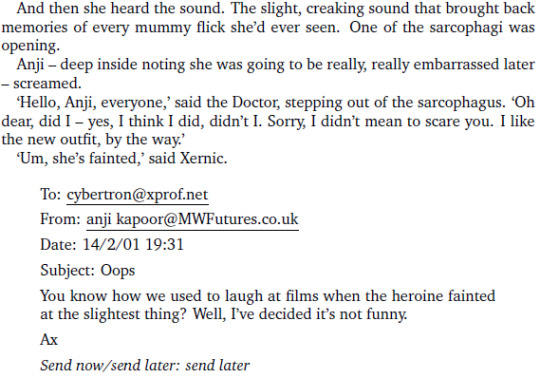
Here’s a quick update on the “Johannes loves Anji” situation

Keep this poster for the TARDIS


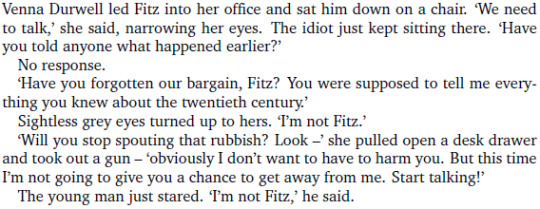
Something is extremely wrong

Meanwhile, in “Eight finds new and interesting ways to hurt himself”
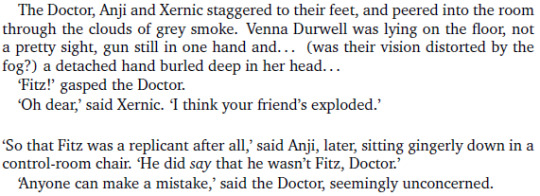
Oh so that Fitz was an android, then.

Every time I think this book can’t get more bonkers, I’m proven wrong

I would pay money to see a tv version of this damn scene

I shouldn’t laugh but I can’t help it

“HE WAS GOING TO HAVE TO PAY ATTENTION TO WHAT HE WAS DOING WHILE HE WAS DISTRACTED”
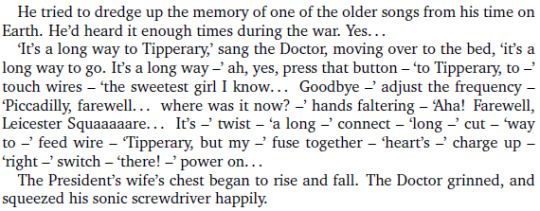
Unexpected Dark Eyes: The Great War feels
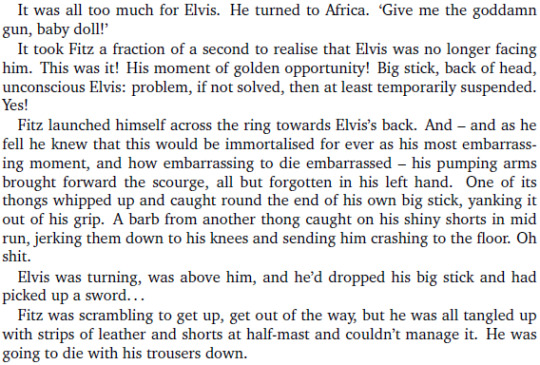
WE HAVE A WINNER, FOLKS
I DON’T THINK FITZ IS EVER GOING TO BEAT THAT AS FAR AS “EMBARRASSING MOMENTS” GO, THAT ONE PUTS “GETTING MUGGED BY A UNICORN FOR A CHOCOLATE BAR” TO SHAME

His life is so full of horrible things that his only reaction to being locked up in a cell with a corpse is “at least it’s not rotting yet”.

Oh shit they found about the TARDIS that can’t be good

“Nothing good could possibly be called ‘the machine’”
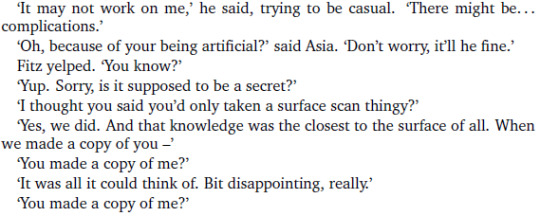


NOT. F█CKING. OKAY.

This is stressful but also fascinating??

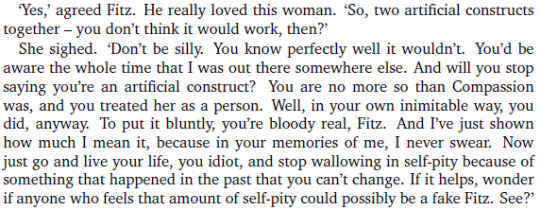
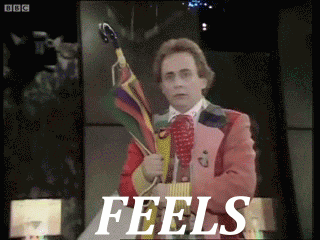

Good. Good.

You’re not telepathic Fitz Kreiner so I doubt she got all that

I completely forgot he had lost his trousers and now I’m laughing again

Told ya

You can’t swim? You can’t swim?? You go through time and space and you can even spacewalk but you can’t swim????
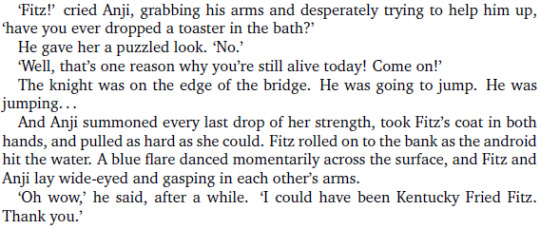
Anji is unexpectedly strong
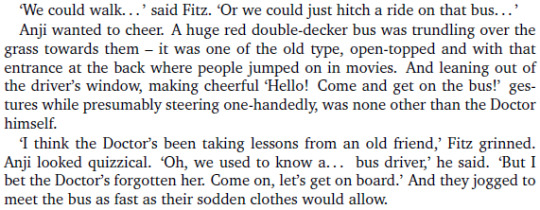
I’m so happy he still remembers Iris on some level even if he couldn’t recognise her in Father Time
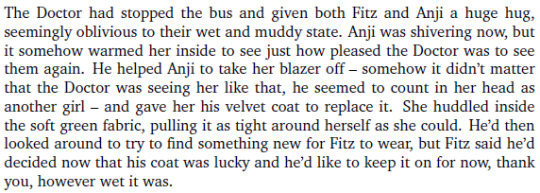
1) Hugs
2) Hugs are good
3) Anji huddled in Eight’s velvet coat
4) “he seemed to count in her head as another girl”
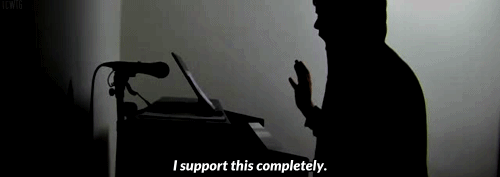

Filed under “need to draw at some point”
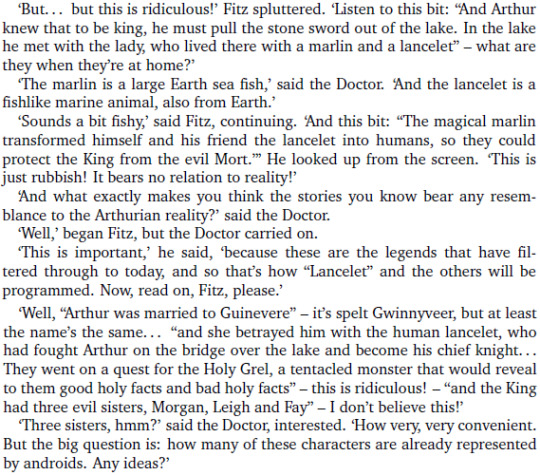
Marlin and Lancelet
I have no words
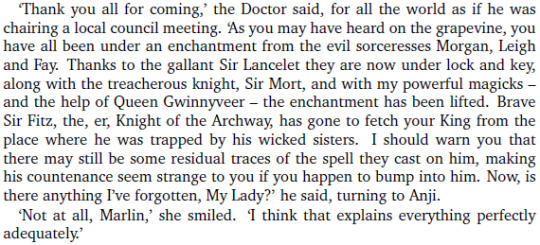
Eight plays “Marlin” because of course he is
Also I’m not screening everything but Anji was brilliant
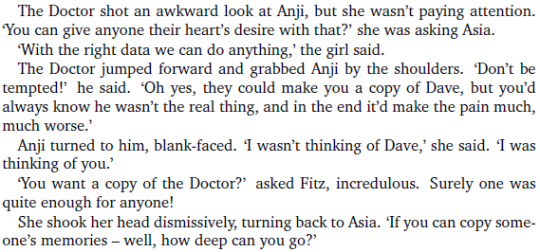
BAD IDEA
VERY BAD IDEA
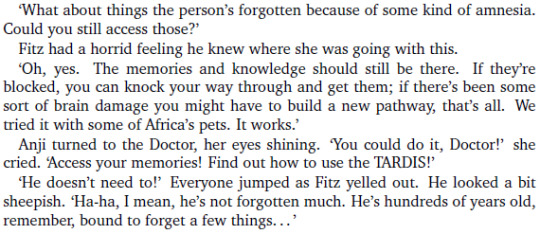
9 OUT OF 10 ON MY SCALE OF BAD IDEAS

FOR ONCE I AGREE WITH FITZ

NOOOOOOO
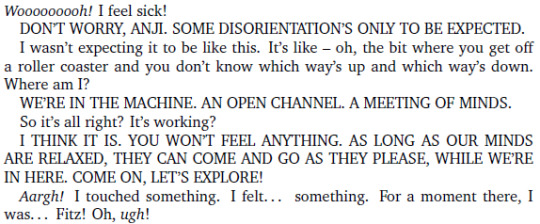
This is so damn weird. Funny and stressful at the same time.
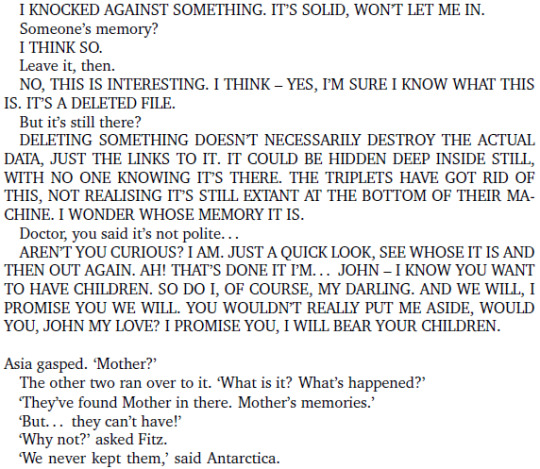
Eight is reliving the memories of the dead queen and it is so f█cking weird
In a good way but still

YES BUT I DON’T WANT TO ALARM ANYONE BUT THEY WERE STILL CONNECTED TO THE THING SO I EXPECT SOME SIDE-EFFECTS

HAHAHA
Also “to Fitz’s incredulous horror”
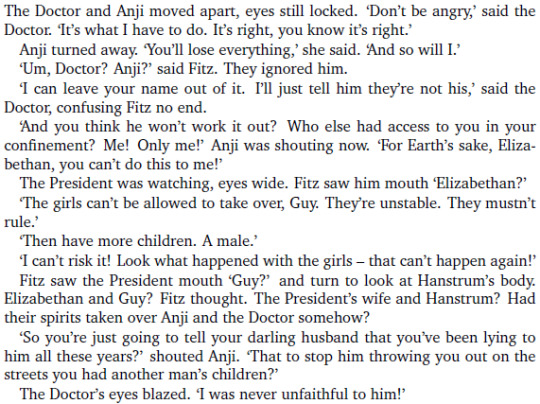

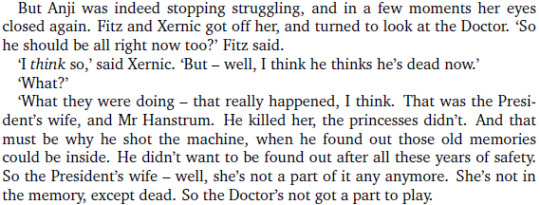
Uh guys
Guys if he thinks he’s dead now, shouldn’t you worry about that or something

I told yoU GODDAMMIT

“quietly pleased”

Oh, that explains quite a lot, actually.

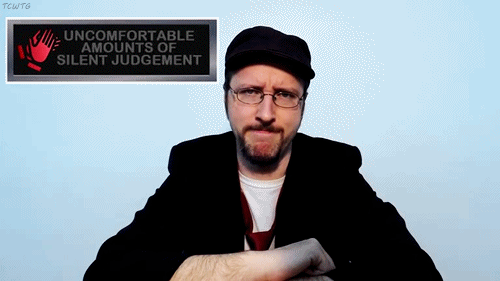

I just realised Anji’s was only coping thanks to pure adrenaline and constant distractions since Dave’s death and she’s inevitably going to crack sooner or later once everything is solved here.

AND STRAIGHT BACK TO THE BAD IDEAS

Hmmm cute?? Not acceptable? Thank you

The TARDIS did a very good job and all is well.

Every time that happened before, that person died, Fitz


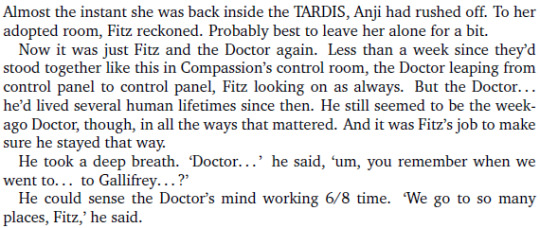
Crisis averted.
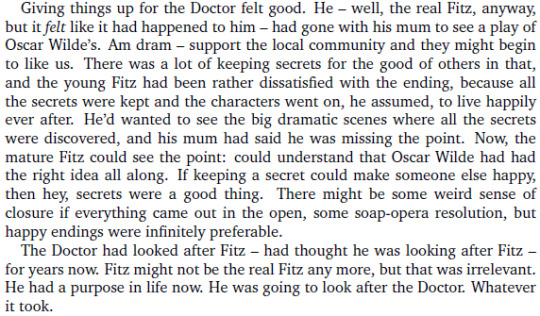
I’m getting surprisingly emotional about all this
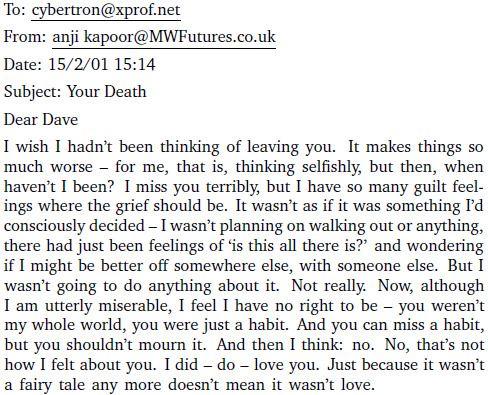
Well I’m really f█cking sad now

Don’t make me cry please Anji oh no
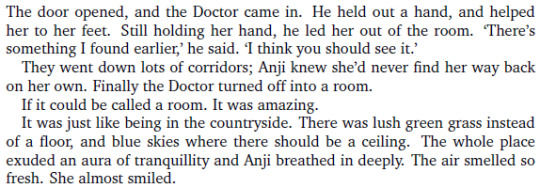
The butterfly room is still there but is now empty after all the butterflies were nailed to that door in The Ancestor Cell and I’m getting teary but also kinda happy, this feeling is extremely confusing

A++ ending, goddammit that last scene was wonderful
#Eighth Doctor#Fitz Kreiner#Anji Kapoor#eighth doctor adventures#Earthworld#EDAs#doctor who#long post#An EDA liveblog full of useless comments#gif#caps lock#violence tw#sex mention tw#(very mild)#(but better safe than sorry)
48 notes
·
View notes
Text
10 Best Films of 2019 That Were Featured on Multiple “Worst of” Lists
I’m back again! I wrote one of these last year and I hesitated to do it again because as the year ramped up, I saw a lot of backlash against “Worst of the Year” lists that, frankly, I am not aligned with. There is nothing wrong with being critical of any and every movie that is produced on such a massive scale. I would even venture to say that there is something distinctly wrong with being so uncritical about the film industry that you eat up whatever they give you. Many worst of the year lists, though, tend to line up with the traditional line of thought that certain films are simply not good, which then means that other films are definitively good. This is where I begin to take issue. A lot of films that are near-unanimously panned have much more value than they’re being given credit for. Not every film on this list is one of those, but a lot of unique voices and projects are mocked, forgotten and/or ignored because of these lists.
Again, this is not a best of the year list, it is ranked by how frequently it appeared on the lists I perused as opposed to how good they are. These are some movies from 2019 that I enjoyed and wanted to stick up for, but I do not object to the concept of a “worst of the year list”, I simply object to these being them when many best of the year lists (see: yesterday’s Oscar nominations) encompass the opposite of what I love watching movies for.
That’s a lot of rambling to say that this list is not that important, but I recommend all of these movies to varying degrees, and I encourage you to follow your gut to see if you should ignore the consensus on some of them!
10. Murder Mystery (2018, Kyle Newacheck) [2 lists]

For me, this is the most energetic Sandler’s low-energy everyman has been in years, really playing up his throwaway jokes which makes them feel even funnier. A fun cast of characters, a fun mystery and makes the case for schlocky mystery novels! Fun!!
9. 47 Meters Down: Uncaged (2019, Johannes Roberts) [tie, 3 lists]

I am a sucker for one-location thrillers and when the location is underwater in a submerged lost city trapped with relentless blind sharks, I had a tough time resisting how much fun this one was. And relentless is the perfect word! Surpassed its predecessor, as far as I’m concerned, and I already thought that one was pretty good.
9. Brightburn (2019, David Yarovesky) [tie, 3 lists]

I heard the premise for this one and was just immediately on board, to be fair. Perhaps that is where a lot of people’s problems with this movie stem from. For me, it did what it promised and although it did not exceed those expectations or expand on its premise much at all, I am sold on something that recognizes that superheroes have power and that an impressionable child living in America is unlikely to wield that power for good.
9. The Intruder (2019, Deon Taylor) [tie, 3 lists]

Carried by three excellent performances, in particular Quaid’s, which instantly made me a fan. The way that director Deon Taylor introduces the character’s calculated “good intentions” allows his evil to reveal itself within the house that he sells to Michael Ealy and Meagan Good’s characters throughout the rest of the film, resulting in something genuinely stomach-turning. One of my favorite horror films this year!
6. Countdown (2019, Justin Dec) [4 lists]

As silly as the idea of a killer app movie may be, it hones in on a fear that is common in some of the best horror films out there: that our death is inevitable, and there’s nowhere we can run to escape it. In tandem with that idea, it introduces a fascinating exploration of faith that counteracts that nihilistic message. Not too different from a tech-centric It Follows, frankly.
5. Replicas (2019, Jeffrey Machmanoff) [7 lists]

Keanu had a huge year in 2019 — John Wick 3, Toy Story 4 and a couple scene-stealing cameos — but very little enthusiasm was directed as the January-released film in which he attempts to clone/revive his family who have died in a car accident. First of all, Keanu brings his all to everything he does and I have to appreciate the integrity that he brings to a low-rent Philip K. Dick knock-off that largely consists of him spending time in a science lab with Thomas Middleditch.
4. Glass (2019, M. Night Shyamalan) [8 lists]

In researching for this list — and upon scrolling through people’s various end-of-the-year takes — I was faced with an unprecedented amount of hate for what I’d consider not only the best film of the year but also what ended up being my favorite film ever. Perhaps it’s just my echo chamber but how this empathetic, minimally-structured take on the superhero genre was received poorly is beyond me.
3. Gemini Man (2019, Ang Lee) [9 lists]

Almost definitely the year’s best action movie, not only for having some of the best set pieces but for, on top of that, choosing to sit in the melancholy of the story it created for much longer than most other action films that come out are willing to do.
2. Hellboy (2019, Neil Marshall) [11 lists]

I can’t exactly explain this one. I see why people dislike it and I certainly see how it is unnecessary considering how Del Toro’s voice shined through and dominated the story of Hellboy in his films. It is also perhaps a blatant attempt to cash in on the success of Deadpool’s smarmy anti-hero, but there is something so much sincere about David Harbour’s turn as Hellboy that it ends up feeling goofy in a much more enjoyable way. I have likened it to the sincerity of Vin Diesel — as if he were trying his luck at an R-rated action franchise about a ragtag group of weirdos — and in that light, it’s difficult (perhaps even hypocritical) for me to dislike it all that much.
1. Serenity (2019, Steven Knight) [13 lists]

Hailed (condemned?) as the year’s most baffling film and it only came out in January! I was on hopelessly board with this thing from its opening frames, though: It’s so confident in its ludicrous mythology that I actually ended up appreciating its emotional wavelength. I give this one a lot of credit for how it steers itself after revealing what may seem like a pretty nonsensical twist.
HONORABLE MENTIONS:
Cats (2019, Tom Hooper) - 4 votes Godzilla: King of the Monsters (2019, Michael Dougherty) - 2 votes Domino (2019, Brian De Palma) - 2 votes Escape Room (2019, Adam Robitel) - 1 vote In The Tall Grass (2019, Vincenzo Natali) - 1 vote What Men Want (2019, Adam Shankman) - 1 vote Little (2019, Tina Gordon Chism) - 1 vote Annabelle Comes Home (2019, Gary Dauberman) - 1 vote 6 Underground (2019, Michael Bay) - 1 vote Extremely Wicked, Shockingly Evil & Vile (2019, Joe Berlinger) - 1 vote
SOURCES:
Looper CBS News Zimbio
Variety Rolling Stone WatchMojo.com Entertainment Weekly Now Toronto Fox 5 Chicago Tribune Hollywood Reporter ABC IGN Yahoo Gamespot EW Jeremy Jahns Gizmodo
0 notes
Text
Stanley Kubrick's "A Clockwork Orange” film-sound analysis

STANLEY KUBRICK Stanley Kubrick was Born in New York City on July 26, 1928, where he worked as a photographer for Lookmagazine to later explore filmmaking in the 1950s directing so some of the cult movies on the cinema’s history, including Spartacus (1960), Lolita (1962), Dr. Strangelove (1964), A Clockwork Orange (1971), 2001: A Space Odyssey (1968), The Shining (1980), Full Metal Jacket (1987) and Eyes Wide Shut (1999) etc. Kubrick is well-known for its elegant juxtaposition of sound in his masterpieces as well as what is referred to as ‘diegetic sound’ (sound which presence is implied off screen by actions which include voices, laughs, distant sounds of objects in the story etc.).
“Kubrick really understood the rhythmic impact of two images coming together. He also had an extraordinary feel for the pace or tempo, a musical term, of a given scene.” (Scorcesse, M.)
#A clockwork Orange
A Clockwork Orange (1971) starts in its opening scene with the Music for the Funeral of Queen Mary, creating a contradiction of order that pervades society therefore listing so a number of issues the movie directs, such as violence, sexual-desire, order, ‘panopticon and panopticism’, Foucault, perception, politics, and furthermore. Kubrick is a real master in implementing a fourth dimension in his movies, by an exquisite choice of classic music (including original one as well as new synthesised versions). The choice of specifically using Henry Purcell, Ludwig van Beethoven, Gioachino Rossini, Nikolai Rimsky-Korsakov, and Edward Elgar’s music, comes as a result of adding up to Kubrick’s main theme which is the idea of: a society of control vs. a society of freedom. What makes it even more extraordinary is the use of a ‘synthesiser’ version of the original symphony as played by Wendy Carlos.

In 1968 a Moog synthesiser was a quite unknown instrument for the time, until Wendy Carlos would remake a whole new version of Johann Sebastian Bach's six "Brandenburg Concertos” and turn it into the most influential Electronic/classical recording of all time, destroying so the separation and distinctive borders between classical and synthesised music. Her work winning three Grammys later on sent an important comment on the world, by marking so a new era where synthesiser started being considered a real instrument and no more just a bizarre tool used to make unusual robotic sounds. At the same time Dolby had long trying to fight Hollywood’s conservative attitude towards new technology, by stating that noise reduction could have a huge impact. It was Rachel Elkind, together with Wendy Carlos that managed to fix a meeting between Ioan Allen (Dolby Studios) and Kubrick to discuss Dolby’s innovative ideas. Kubrick accepted to be the experiment on these new technologies, not knowing he would shape the further sound design of Hollywood productions.
The film industry noticed the impact the sound had on a Clockwork, therefore the use of Dolby technology became the standard. Jumping back on the storyline:
Quite Shakespeare-like, Alex – who is also the narrator – uses made up words to introduce us to his “droogs”. There are four of them including Alex, and they are all in white clothes. So far, we are seeing and hearing arbitrary and extraordinary things and words, a total challenging of concepts of normality, order, language (therefore perception) and society. This distorted language and setting meets perfectly with the synthesiser version of Purcell – the distortion of harmony, melody and order. The narrator tells the audience that the kind of drugged milk they drink gives them the energy they need for the good old “ultra-violence”. By ultra-violence, Alex means rape and violence, which he and his “droogies” are so fascinated by. This power to commit acts of violence comes from the breasts of a woman (like a mother figure), but both the milk (drug) and the mother figure (nude, posing seductively) is tainted just like the way something just as pure as classical music is tainted with a synthesiser. Moving forward to another scene the gang are seen to approach a “HOME” where a married couple depicting sophistication and order live, for some more violence. By the time they ring the doorbell the first notes of Beethoven’s 5th symphony’s emerge by giving so the message that something is about to happen (furthermore the movie reveals, Beethoven as a depiction of an alarm for another violent event about to happen) What happens next is pure acts of violence and rape, where they tie and beat up the old man and force him to watch the rape of his wife, while right at this moment Carlos’ synthesised version of Purcell emerges and starts playing again, throwing the audience again in disorder, apathy and lack of humanity. Back on Korova Milk Bar which seems to be this reflecting symbolic environment where the movie goes back and forth for more ‘hidden’ symbolic and metaphorical messages and where Alex embraces his role as the narrator, the focus jumps this time to the characters around the room, who make Alex and the rest of the gang look unfit for the place with their bowties and suits. At this exact moment a woman starts singing Beethoven symphony 9 right after Purcell came to an end. As he enters the apartment building, a different synthesiser version of Purcell is heard while Alex still whistles along. And as soon as that different version is heard, the camera turns to an art piece where are penises drawn or scratched on nearly every depiction of man, and there are many other drawings on the actual art piece that make fun of the painting. This childish mocking and degrading of art is also the continuity of disorder, violence and sex motives of the film. In this case, Purcell’s different synthesiser version somehow refers more to the disruption of art and perception, and not mainly to physical violence and rape. Purcell is the holistic account of the film. As Alex enters the apartment, what is heard is another synthesiser version of Purcell, to right away show around drawn penises turned to art pieces, and drawings of them on top of real art pieces and so on, to a hysterical extent. The comment Kubrick is trying to make in this scene, is just a further depiction of disruption, disorder and mocking chaos.
“Purcell is the holistic account of the film.” (Bali, S.)
What depicts the heaviest symbolism of all scenes after the audience have have been involved in the roller-coaster of sound switch from classical to synthesised/distorted understanding finally what each one represents in this spiral of order and disorder, is Alex entering his room, giving us the first private approach, in a moment when the transition from Purcell’s “disorder” into the original version of Beethoven’s Symphony 9 happens.
What is definitely not expected in this scene is the tidiness in Alex’s room which does not fit with the image portrayed so long into the movie of him, but the order found in his surrounding now justifies Beethoven’s Symphony 9. What the order in his room is trying to depict is what was forced and the influence educated by his parents, since in this scene we also find out he still lives in his parent’s house.
The parallelism is given in the sense of Alex’s parents disrupting his inner/real nature in the same way that Kubrick uses synthesiser to distort Purcell. Alex is given as a representation of a new shaping in society, destroying so violently an imposed order by society, by the same matter that Carlos new understanding of music breaks the barrier of the untouchable classical music.
However, what one can state is also that Alex never really commits the acts of violence while Symphony 9 plays, but instead he just imagines them.
The Guillame Tell’s overture on the other hand fits the next scene perfectly as if it was made for it.
“It seemed to me a good way to satirise what had become the fairly common use of slow-motion to solemnise this sort of thing, and turn it into ‘art’. The Guillaume Tell’s Overture also seemed a good musical joke to counter the standard Bach accompaniment.” (Kubrick, S.)
Next, the film takes another turn and the scenery changes, as Alex is imprisioned for fourteen years. An above point of view is given of the prison while Guillaume Tell’s overture / opera is playing non-diegetically to glorify Alex’s fight against authority and make the audience sympathise him a bit.
This is however the first very obvious reference of Jeremy Bentham’s panopticon.
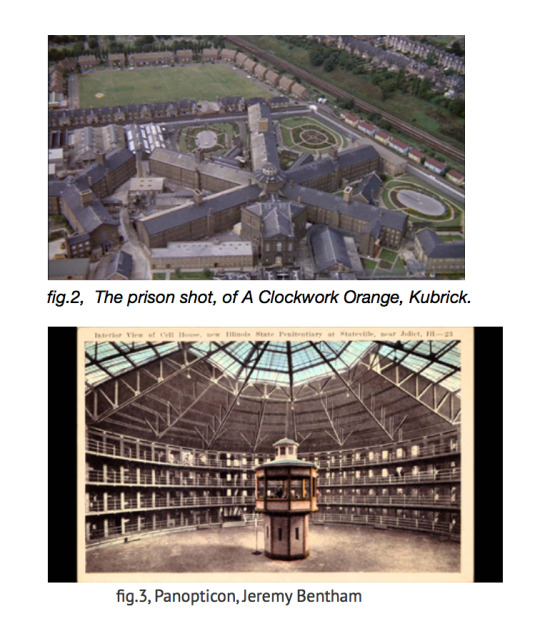
Panopticon is an architectural project for a prison, drawings of which were published on 1791 by Jeremy Bentham. The prison consists of a circular architecture, where cells are placed on the external wall facing the main central tower, where that main point would keep the surrounding cells constantly under surveillance without the prisoners knowing when they would be watched.
What Michel Foucault did later in 1975 was apply this architectural design to develop it further and apply it as a theory to modern society, in his book Discipline and Punish. “Knowledge linked to power, not only assumes the authority of 'the truth' but has the power to make itself true.” (Foucaul, M.)
Furthermore, Foucault discusses that a constant surveillance of society becomes part of the observed’s nature to a certain point that the observed becomes on its own an apparatus of surveilling himself. Regarding Alex’s time in the prison, he dedicates it to reading the Bible and imagining all sort of controversial scenes of whipping Jesus while Nikolai Rimsky-Korsakov’s Scheherazade: the Sea and Sinbad’s Ship plays as the soundtrack. However all the flow of his imagination is interrupted by the priest of the prison. For the first time in the film we hear the term Ludovico Treatment, which apparently was a form of therapy, while Alex requests from the priest to be used on him. Right here, we have another reference and example of Foucault’s theory, on how Alex himself depicts an eagerness to be treated. During the whole film, Kubrick seems to mock England’s authority, by overdramatising everything from the acting to the sound use to a level that it almost becomes a parody, and this is enforced even more when the Minister of the Interior of England pays a visit to the prison to inspect furthermore the order. Elgar’s Pomp and Circumstance March No.1 is Kubricks choice for this particular scene, which takes the mockery of England’s authority to another level, stating the obvious.
Furthermore, one of the most uncomfortable/controversial moments of the movie emerges: Alex’s treatment. During his treatment Alex is given a paralysis drug in order for him to remain static while he is forced to watch various depictions of violence and rape in the screen. At the moment Hitler appears and concentrations camps, distorted Wendy Carlos’ version of Beethoven’s symphony 9 emerges once again, diegetically. At this particular moment the audience is already been trained through the movie that that is the main trigger for disorder and that this symphony remains precious and untouched to Alex. Alex requires the interruption of the treatment while yelling “It’s a sin! He did no harm to anyone! Beethoven just wrote music!”
As for Foucault’s relation to the sound use of Kubrick, it gets its explanation and becomes more obvious by this particular moment.
Explaining the symbolisms: The “panopticon” prison and Ludovico Treatment Facility are references to the observing society. Alex - the antithesis of society has finally reached what Foucault argued as the peak where the observed makes a natural habit of his own surveillance. Beethoven - on the other hand is a representative of Alex’s nature, the real him, what makes him the unfit for the society and what they ware aiming to treat and change about him. His awareness of him destroying his own true self is what triggers him to beg them to stop. the Guillaume Tell – depicting the oppression of revolt as Alex is taken to the prison/panopticon.
By the ending of the treatment, the Minister of the Interior organises a presentation of Alex, which does indeed ring a bell, reminding one of modern society governments showcasing their authority and control with each success, but what draws really the attention here is the phrase “Observe all” a direct reference to panopticism.
The emerge of another overly theatrical scene of mockery where someone shames and violates Alex to the point of licking his shoe, accompanied in the mean time by musical non-diegetic sounds, presents a changed Alex disgusted by it all. His disgust grows bigger when they put a woman only wearing underpants in front of him, where the idea of bare breasts emphasises the disgust he feels. However on this particular moment a non-diegetic synthesized version of Purcell emerges to depict the sexual desires of Alex, but however he does not respond to that desire anymore. Regarding his return home, he shortly after arriving finds out someone replaced him in his room, and his parents do not want anything to do with him anymore. As we empathically feel Alex’s sadness the Guillaume Tell’s overture starts playing non-diegetically, depicting once more since the prison scene the oppression of revolt and the winning of authority. Lately, Purcell emerges once more when Alex get confronted by Dim and George (his used to be droogs), at this moment they try to drown him and hit him with a truncheon, but however the interesting element here is that the truncheon sound starts interacting by distorting the music on each hit, and since Purcell depicts Alex, we get a portrayal of a weaker Alex. The movie seems to be taking a circular curve, turning back to the places which are already fmiliar for the audience such as the home where Alex raped a wife in front of her husband, for Alex to find out the writer is crippled and his wife died. Alex relaxes taking a bath and joining for dinner while the writer drugs him. The writer, mr. Alexander, is in fact part of a party which is strongly against the Ludovico treatment method, considering it highly inhumane. What the whole plan consists is on making Alex suicide in order to show how dangerous and unbenefitable the treatment is, but also to benefit on the scandal to replace the actual government.
Beethoven’s 9th symphony emerges once more ripping Alex off his humanity, and since the version playing it’s the synthesized/sitorted one, it is depicting the corruption of the party, who hypocritically are against inhumanity but are at the same time sacrificing Alex.
Next is a vibrant version of Purcell playing while Alex wakes up to find his parents present in the hospital, regarding an accident, of him throwing himself from the window. However this version of Purcell depicts also the change in Alex, following tests done by a psychiatrist. However since Alex mentions dreams he had about someone interacting with his brain, one can fairly suggest that another treatment has taken place this time without any consent. What follows later, is a visit from the Minister of the Interior who recites his prepare speech and continues by making Alex knee to his power.
The movie ends with a pair of gigantic speakers playing the finale of the original version of Beethoven Symphony 9 while Alex smiles in relief while he is dro wn back in his imagination of raping and the society applauding him. However, one will forget the crimes of Alex and instead be cheered on the side of the ruling party, while he himself becomes a tool of propaganda and bows down to authority.
As a conclusion, Purcell and Beethoven are the holistic accounts of the movie. The music choice of Kubrick is creating indeed paradoxes and contradictions of being outlandish, disturbing and at times comforting. What the electronic sounds of Carlos’ synthesizer did was giving the movie it’s 4th dimension of atmosphere. Therefore the music was integral to the story. The comforting order scenes were given by the original classics while the disturbing violent ones were alerted by Carlos’ treatment of the originals by distorting them making these scenes even more controversial. Lastly, Kubrick’s genius treatment of implementing the panopticism theory to explain governmental surveillance and how we suppress instincts due to a panopticon surveillance, adds up as the strongest comment on his film, ending it with a strong statement of control and authority as we observe Alex bow down and accept becoming a tool of propaganda for the leading party. ___________________________________________________ #REFERENCES
Scorcesse, M. Available at: http://old.bfi.org.uk/sightandsound/filmmusic/scoring.php Accessed: [ 11 April 2018] Macris, A. The Immobilised Body: Stanley Kubrick’s A Clockwork Orange Accessed: [11 April 2018] Foucault, M. (1995) Discipline and Punish: The Birth of the Prison. New York: Vintage Accessed: [11 April 2018]
#Bibliography
Foucault, M. (1995) Discipline and Punish: The Birth of the Prison. New York: Vintage McDougal, Stuart Y. (2003) Stanley Kubrick's A Clockwork Orange. Cambridge: Cambridge UP. 125. Google Books. Google Inc. Web. 21 May 2016. .
Ciment,M. (2003) Kubrick: The Definitive Edition
Burgess,A. (1988) A Clockwork Orange (Harmondsworth: Penguin,)
Polan, D. (1989) “Jack and Gilles: Reflections on Deleuze’s Cinema of Ideas”, Art and Text, vol. 34 , pp. 23-30 Barr, Ch. (1972) “Straw Dogs, A Clockwork Orange and the Critics”, Screen, vol. 13, no. 2 Duncan, P. (2003). Stanley Kubrick: The Complete Films. McDougal, Stuart Y. (7 July 2003). Stanley Kubrick's A Clockwork Orange Volkmann, M. (16 October 2006). "A Clockwork Orange" in the Context of Subculture Powrie, P. and Stilwell, R. (2017). Changing Tunes: The Use of Pre-existing Music in Film. London. McQuiston, K. (2013). We'll Meet Again: Musical Design in the Films of Stanley Kubrick. p.Chapter 7 Musical Dialectics and the More Troublesome Beethoven. Geselowitz, M. (2016). The Masterpiece Behind the Music in A Clockwork Orange - IEEE - The Institute. [online] Theinstitute.ieee.org. Available at: http://theinstitute.ieee.org/tech-history/technology-history/the-masterpiece-behind-the-music-in-a-clockwork-orange [Accessed 30 Apr. 2018]. #LIST OF IMAGES: fig.1, McDonald, N. Meet Wendy Carlos: Godmother of Electronic Music and Badass Trans Woman. [image] Available at: https://thump.vice.com/en_ca/article/53agdb/meet-wendy-carlos-godmother-of-electronic-music-and-badass-trans-woman [Accessed 5 May 2018]. fig.2, [image] Available at: https://i.pinimg.com/736x/d7/53/f7/d753f70524fa077121006012de3ecbce--a-clockwork-orange-prison.jpg [Accessed 5 May 2018]. fig.3 Bentham, J. , panopticon. [image] Available at: http://www.ethics.org.au/on-ethics/blog/july-2017/explainer-the-panopticon [Accessed 5 May 2018].
0 notes
Text
Today I am delighted to host author Catherine Kullman on the blog as she shares her #bookloves with us all. Before we find out Catherine’s secret love, here’s a little about the woman herself.
About Catherine
Historical Fiction for the Heart and for the Head
Catherine Kullmann was born and educated in Dublin. Following a three-year courtship conducted mostly by letter, she moved to Germany where she lived for twenty-six years before returning to Ireland. She has worked in the Irish and New Zealand public services and in the private sector. After taking early retirement Catherine was finally able to fulfil her life-long ambition to write. Her novels are set in England during the extended Regency— that fascinating period between the demise of hoops and the invention of crinolines- the end of the Georgian era but before the stultifying age of Victoria.
Her debut novel, The Murmur of Masks, published in 2016, is a warm and engaging story of a young woman’s struggle to survive and find love in an era of violence and uncertainty. It takes us from the ballrooms of the Regency to the battlefield of Waterloo. In November 2016, it was honoured with a Chill with a Book Readers Award.
In Perception & Illusion, published in March 2017, Lallie Grey, cast out by her father for refusing the suitor of his choice, accepts Hugo Tamrisk’s proposal, confident that he loves her as she loves him. But Hugo’s past throws long shadows as does his recent liaison with Sabina Albright. All too soon, Lallie must question Hugo’s reasons for marriage and wonder what he really wants of his bride. “I loved your protagonists and the depth you gave to their emotional journeys and to the rest of the characters and story. Bravo! It was a lovely read, deliciously romantic with wonderful characters, elegant writing and perfect period detail. Hugely enjoyable!“ Nicola Cornick
Catherine Kullmann is represented by A for Authors. You can follow Catherine on her website or Facebook.
…
The Murmur of Masks
It is 1803. The Treaty of Amiens has collapsed and England is again at war with France. Eighteen-year-old Olivia must say goodbye to her father and brother, both of whom are recalled to active service in the navy. Not long afterwards, her mother, who has been her anchor all her life, dies suddenly. As a result, she loses her home. Adrift and vulnerable, she accepts the offer of a marriage of convenience from Jack Rembleton, an older man whose brother, Lord Rembleton, is pressuring him to marry and sire the heir to the title Rembleton has failed to provide. Olivia hopes that love will grow between them, but Jack’s secrets will prevent this and Olivia must learn that she has thrown away her youth and the chance of love.
When Luke Fitzmaurice, a young man prevented by ill-health from joining the army, meets Olivia at a ball, he is instantly smitten but she must tell him she is already married. Ten years pass, during which each faces up to life’s challenges but then fate throws them together again. Olivia is finally free, but before they can explore what might be between them, Napoleon escapes from Elba and Luke, who is determined this time not to be found wanting, joins Wellington’s army in Brussels.
Perception & Illusion
Cast out by her father for refusing the suitor of his choice, Lallie Grey accepts Hugo Tamrisk’s proposal, confident that he loves her as she loves him. But Hugo’s past throws long shadows as does his recent liaison with Sabina Albright. All too soon, Lallie must question Hugo’s reasons for marriage and wonder what he really wants of his bride.
Perception & Illusion charts Lallie’s and Hugo’s voyage through a sea of confusion and misunderstanding. Can they successfully negotiate the Rocks of Jealousy and the Shoals of Perplexity to arrive at the Bay of Delight or will they drift inexorably towards Cat & Dog Harbour or the Dead Lake of Indifference?
Catherine Kullmann skillful evocation of the Regency period rings true, as do her protagonists’ predicaments. It is a joy to step into this other world with her.
Childhood Sweetheart Favourite book from childhood
Childhood Sweetheart: Your favourite book from childhood.
The Swiss Family Robinson by Johann Wyss. First published in 1812, this is a thrilling story of a shipwrecked family who make a new life for themselves on an uninhabited but extremely lush and fruitful island. Fortunately the polymath of a father can identify everything and the practical mother thinks of the small essentials like needles and thread. I still have the old copy with flimsy pages and beautiful steel engravings of the flora and fauna of the island that my father bought second-hand when I was a child, although it was read to bits. I since have acquired several copies-I can never pass a good edition, and my dream is to have a first edition. Funnily enough, although it was originally written in German (the author was Swiss), it is not well known in Germany today. However, I was lucky to find a lovely edition published to mark the one hundred-and-fiftieth anniversary in 1952 and bought it for my sons, who loved it too.
First love The first book you fell in love with
What Katy Did by Susan Coolidge. I cried my eyes out when Katy fell out of the swing and was unable to walk for ages.
Biggest book crush The book character you’re totally in love with
Gervase Frant, Earl of St. Erth, from The Quiet Gentleman by Georgette Heyer. He is a splendid mix of her Mark 1 and Mark 2 heroes.
Weirdest book crush Well… duh
The dead sea-captain, Captain Gregg the ghostly author of Blood and Swash in The Ghost and Mrs Muir by R. A. Dick
Hardest break up The book you didn’t want to end
I recently read The Phantom Tree by Nicola Cornick, a fantastic time travel mystery. I was dying to know what happened but didn’t want it to end. Hmm— I must read it again.
The one that got away The book in your TBR or wish list that you regret not having started yet.
None. My regrets are for the books that have not been written, perhaps because their authors that left us too soon like Ariana Franklin (Diana Norman) and Sylvain Hamilton or those who only wrote a few books. Valerie Fitzgerald, for example, wrote the magnificent Zemindar, a sweeping story set during the Indian Mutiny, but never published anything else. And Patricia Wentworth’s Miss Silver frequently refers to the affair of the poisoned caterpillars, but I have never worked out which book it is. And I hope that Naomi Novik returns at some time to Lawrence and Temeraire. Why hasn’t Gillian Bradshaw set more books in classical Greece and Rome? I could go on and on
Secret love Guilty Reading pleasure
Perhaps my taste for werewolves, vampires and assorted others. See below
Love one, love them all Favourite series or genre
There are so many—I love series. Favourites include Elizabeth Vaughan’s Chronicles of the Warlands—I am so pleased that she has started writing again urban fantasy from Patricia Briggs, Eileen Wilks and Nalini Singh, historical mystery such as Lindsey Davis’s Falco and Flavia Albia series, Wendy Hornsby’s Maggie McGowan mysteries, J D Robb’s futuristic Dallas and Rourke mysteries.
Your latest squeeze Favourite read of the last 12 months
The Strangler Vine by M J Carter. Set in India in 1837 it successfully marries the old-fashioned ripping yarn with modern post-imperial sensibilities
Blind date for a friend If you were to set a friend up with a blind date (book) which one would it be?
A wonderful surprise for lovers of golden age mysteries would be Jill Paton Walsh’s triumphant continuation of Dorothy L Sayers unfinished, last novel Thrones, Dominations, a book of which no less a person than P D James said, “I didn’t myself believe the job could satisfactorily be done, but she has proved me wrong’.
Greatest love of all Favourite book of all time.
. This is a really hard one, but I think I’ll plump for The Swiss Family Robinson because of all the memories it evokes for me. And I still love to read it. It would be a good desert island book too.
…
Thanks Catherine. You know I like your take on the one that got away. I’ve never really thought about the books I wish had been written before. Good answer! And some really interesting looking books there.
What do you think guys? Any of these take your fancy. I can totally agree that the J.D. Robb books are fab and highly recommended. Might have to take a gander at some of the other titles myself I think.
Make sure you stop by again next week when I have the absolutely lovely Katherine Sunderland and Jane Cable sharing their very own #booklove with us all.
Have a brilliant day.
JL
#BookLove: Catherine Kullman Today I am delighted to host author Catherine Kullman on the blog as she shares her #bookloves with us all.
0 notes